THE BE YOUR OWN ECONOMIST ® BLOG
Here’s January’s economic-indicator publication schedule, followed by a list of web sources. Future postings will discuss these indicators.
You can use the WEB SOURCES listing to find the data on your own and read the accompanying press release. The addresses take you to the source’s home page and the steps tell you how to navigate the site. That way (rather than provide a direct link to the data) you can become familiar with these sites and find additional information on your own.
PUBLICATION SCHEDULE
January 2008
Source (* below)…………Series Description…………Day & Date
Quarterly Data
BEA…………………………GDP………………………...……Wed, 30th
Monthly Data
ISM……………….Purchasing managers’ index….....Wed, 2nd
BLS……………….Employment……………………………Fri, 4th
Fed………………..Consumer credit………………..…….Mon, 7th
Census…………...Balance of trade………………………Fri, 11th
BLS……………….Producer prices……………………….Tue, 15th
Census…………...Retail trade…………………………….Tue, 15th
Census……….....Inventories……………………………..Tue, 15th
BLS……………...Consumer prices……………………...Wed, 16th
Fed……………….Industrial production……………….Wed, 16th
Fed……………….Capacity utilization……………….….Wed, 16th
Census…………..Housing starts………………………….Thu, 17th
Conf Bd………….Economic Indicators…………..…….Fri , 18th
Census…………..Capital goods……………………….…..Tue, 29th
Conf Bd………….Consumer confidence………………Tue, 29th
Census…………..New-home sales…………………….Mon, 28th
NAR………………Existing-home sales………….…….Thu, 24th
BEA………………Personal income………………………Thu, 31st
* BEA = Bureau of Economic Analysis of the U.S. Department of Commerce
* Census = U.S. Bureau of the Census
* Conf Bd = Conference Board
* Fed = Federal Reserve System
* ISM = Institute for Supply Management
* NAR = National Association of Realtors
WEB SOURCES
Index of Leading Economic Indicators
http://www.conference-board.org/
Step 1: Click on "Economics" in the left-hand menu bar
Step 2: Click on "Economic Indicators" under "Economics" in the left-hand menu bar
Step 3: Click on link under "U.S. Leading Indicators"
Gross Domestic Product
http://www.bea.gov/
Step 1: Click on "Gross Domestic Product" under "National"
Step 2: Click on "National Income and Product Accounts Tables" under "Gross Domestic Product (GDP)"
Step 3: Click on "list of all NIPA Tables"
Step 4: Click on "Table 1.1.6. Real Gross Domestic Product..." and "Table 1.1.1. Percent Change..."
Step 5: Scroll down to line 1 in both tables and go to the last column on the right
Industrial Production & Capacity Utilization
http://www.federalreserve.gov/
Step 1: Click on "All Statistical Releases" under "Recent Statistical Releases" and then click on "Industrial Production and Capacity Utilization" under "Principal Economic Indicators" in the upper left
Step 2: Click on "Current Monthly Release"
Step 3: Find the latest monthly data in the table next to "Total index" and "Total industry"
Institute For Supply Management Index
http://www.ism.ws/
Step 1: Click on "ISM Report on Business" in left-hand menu bar
Step 2: Click on “Latest Manufacturing ROB” and find the latest PMI
Producer Prices
http://stats.bls.gov/
Step 1: Click on “Producer Price Indexes” under “Inflation & Consumer Spending” in left-hand menu bar
Step 2: Note "Finished goods" under "Latest Numbers" in upper right and multiply by 12 to put the data on an annual basis
Business Capital Expenditures (Nondefense Capital Goods)
http://www.census.gov/
Step 1: Click on "Economic Indicators" in the lower right
Step 2: Click on "PDF" on the left under "Advance Report on Durable Goods Manufacturers' Shipments and Orders"
Step 3: Scroll down to Table 1 and find new orders for nondefense capital goods near the bottom
Inventories, Sales & Inventory/Sales Ratio
http://www.census.gov/
Step 1: Click on "Economic Indicators" in the lower right
Step 2: Click on "HTML" on the left under "Manufacturing and Trade Inventories and Sales" Step 3: Scroll down to Table 1 and subtract previous month's inventories from latest month's and multiply by 12 to obtain inventory change, and then obtain the most recent inventory/sales ratio
Consumer Price Index
http://stats.bls.gov/
Step 1: Click on “Consumer Price Index” under “Inflation & Consumer Spending” in left-hand menu bar
Step 2: Note "CPI-U..." at the top under "Latest Numbers" in upper right and multiply "SA" by 12 to put the data on an annual basis
Employment Data (Total Non-farm Payroll Employment) (Unemployment Rate) (Manufacturing Workweek)
http://stats.bls.gov/
Step 1: Click on “National Employment” under “Employment & Unemployment” in right-hand menu bar
Step 2: Click on (HTML) following “Employment Situation Summary” under "Economic News Releases"
Step 3: Click on “Employment Situation Summary” under “Table of Contents”
Step 4: Scroll down to Table A and find the unemployment rate for all workers in the latest month, the change in nonfarm employment in the last column and manufacturing hours of work for the latest month
Personal Income
http://www.bea.gov/
Step 1: Click on "Gross Domestic Product" under "National"
Step 2: Click on "National Income and Product Accounts Tables" under "Gross Domestic Product (GDP)"
Step 3: Click on "list of all NIPA Tables"
Step 4: Click on "Table 2.6 Personal Income..."
Step 5: Scroll down to line 1
Consumer Confidence
http://www.conference-board.org/
Step 1: Click on the "Economics" in the left-hand menu bar
Step 2: Click on "Economic Indicators" under "Economics" in the left-hand menu bar
Step 3: Click on link under "Consumer Confidence Index"
Consumer Credit
http://www.federalreserve.gov/
Step 1: Click on "All Statistical Releases" under "Recent Statistical Releases" and then click on "Consumer credit -- G19" under "Household Finance" in the upper right
Step 2: Click on "Current Release"
Step 3: Go to "Amount ... billions of dollars" and subtract previous month from current month & multiply by 12 to obtain seasonally adjusted dollar amount at annual rate
Housing Starts
http://www.census.gov/
Step 1: Click on "Economic Indicators" in the lower right
Step 2: Click on "PDF" on the left under "Current Press Release" under "Housing Starts/Building Permits"
Step 3: Scroll down to "Housing Starts"
Home Sales (Existing-Home Sales)
http://www.realtor.org/
Step 1: Click on "Research" in the left-hand menu bar
Step 2: Find "Existing-Home Sales" under "Housing Indicators"
Home Sales (New-Home Sales)
http://www.census.gov/
Step 1: Click on "Economic Indicators" in the lower right
Step 2: Click on "PDF" on the left under "Current Press Release" under "New Home Sales"
Retail Sales
http://www.census.gov/
Step 1: Click on "Economic Indicators" in the lower right
Step 2: Scroll down to "Advance Monthly Sales for Retail and Food Services" and click on "HTML" on the left under "Current Press Release"
© 2007 Michael B. Lehmann
Monday, December 31, 2007
Saturday, December 22, 2007
This Time It’s Different
THE BE YOUR OWN ECONOMIST ® BLOG
At the height of the late-1990s dot.com boom, New Economy advocates insisted, “This time it’s different,” because (they believed) rising productivity (efficiency) ensured continually rising corporate earnings. Soaring profits guaranteed the stock market would never cease climbing. As long as inflation remained at bay, the engine couldn’t stall. (Because – they thought - only rising inflation brought the higher costs that eroded profit margins.) As we now know, profits stopped rising when full employment boosted wage costs without generating inflation (modest capacity-utilization rates and cheap imports restrained prices). Slumping profits stopped the boom and the bubble burst.
Something similar happened at the height of the recent real-estate boom. Lenders and their advocates (such as the Federal Reserve), insisted this boom was different because of inflation’s absence. Therefore interest rates would not rise and snuff out the mortgage lending that powered the boom. Besides, lenders’ new instruments brought the possibility of homeownership to an ever-wider circle of Americans, constantly expanding the market for new homes. The boom would keep rolling along. The boom’s advocates didn’t realize that a bubble could form without inflation’s presence, and that risky lending practices could imperil financing. Now that the air is escaping from the bubble, it’s not clear that the Fed’s expansionary policy can stop the leak.
Ironically this real-estate boom was different in at least one important way, and that impedes the Fed’s attempts to rescue the economy. See the December 19 article by George Anders in The Wall Street Journal, available at (http://online.wsj.com/article/SB119802116320237959.html).
Mr. Anders observes that shrinking down payments, or their complete absence, have eroded some home owners’ commitment to their homes. In the past substantial down payments buttressed home owners’ commitment to their property. Loan default and abandonment meant forsaking the home owners’ stake in the house. Since buyers had some skin in the game, they were reluctant to walk away from their homes. Today’s buyers are more likely to abandon their properties because they have nothing to lose.
As Mr. Anders put it:
“Because of lax lending standards in the past few years, many homeowners never amassed much equity in their homes. Sizable down payments became a rarity, as many buyers borrowed close to 100% of the purchase price through a blend of first mortgages and home-equity lines of credit. Others kept refinancing their mortgages as property prices climbed, taking on bigger loans and draining the equity value of their homes.
“As a result, there is a new class of homeowners in name only. Because these people never put up much of their own money, they don't act like owners, committed to their property for the long haul. They behave more like renters, ducking out of an onerous lease in the midst of a housing slump.
“In such an environment credit scores don't really provide a definitive gauge of how hard a borrower will work to avoid default, says Mark Zandi, chief economist of Moody's Economy.com Inc., a West Chester, Pa., economic-research firm. A better test, he says, is how much equity owners have in their home. If they have a lot at stake, default becomes almost unthinkable. Without much equity, the commitment to keep paying the mortgage, no matter painful that may be, begins to dwindle.
“How did banks' lending standards get so far off course? Familiar answers include a race for market share, a herd mentality and the apparent profitability of risky lending in boom times.”
If the real-estate bust does drag the economy down into a slump, there’s another way this time may be different. The Fed’s expansionary policies easily cured past recessions that had been instigated by rising prices and interest rates. As soon as recession halted the inflation, and the Fed’s expansionary policies depressed interest rates, borrowing and spending snapped back. The economy was off and running again. Low interest rates cured the 2001 recession by substituting a real-estate bubble for the dot.com bubble.
This time, however, falling interest rates may not work effectively to re-start demand. The residential real-estate market may be too depressed for lower interest rates to work their magic. Why buy an asset with little prospect for appreciation?
That could present a different kind of problem for the American economy. It may begin to resemble Japan’s economy in the 1990s. Japan took more than a decade to recover from its real-estate bust and its economy consequently languished.
As the December 15 Economist (http://www.economist.com/research/articlesbysubject/displaystory.cfm?subjectid=2764524&story_id=10286992) said:
“Another month, another bank in trouble, another raised estimate of bad assets in the financial system, and another move by the central bank to try and contain the problem: to observers in Japan, America's spreading credit crunch has an eerily familiar ring.
“Though differences between the subprime crisis and the bursting of Japan's own property bubble after 1989 are inevitably great, the similarities are striking.”
This time may really be different if the Fed’s expansionary policy can’t work its magic once more.
© 2007 Michael B. Lehmann
At the height of the late-1990s dot.com boom, New Economy advocates insisted, “This time it’s different,” because (they believed) rising productivity (efficiency) ensured continually rising corporate earnings. Soaring profits guaranteed the stock market would never cease climbing. As long as inflation remained at bay, the engine couldn’t stall. (Because – they thought - only rising inflation brought the higher costs that eroded profit margins.) As we now know, profits stopped rising when full employment boosted wage costs without generating inflation (modest capacity-utilization rates and cheap imports restrained prices). Slumping profits stopped the boom and the bubble burst.
Something similar happened at the height of the recent real-estate boom. Lenders and their advocates (such as the Federal Reserve), insisted this boom was different because of inflation’s absence. Therefore interest rates would not rise and snuff out the mortgage lending that powered the boom. Besides, lenders’ new instruments brought the possibility of homeownership to an ever-wider circle of Americans, constantly expanding the market for new homes. The boom would keep rolling along. The boom’s advocates didn’t realize that a bubble could form without inflation’s presence, and that risky lending practices could imperil financing. Now that the air is escaping from the bubble, it’s not clear that the Fed’s expansionary policy can stop the leak.
Ironically this real-estate boom was different in at least one important way, and that impedes the Fed’s attempts to rescue the economy. See the December 19 article by George Anders in The Wall Street Journal, available at (http://online.wsj.com/article/SB119802116320237959.html).
Mr. Anders observes that shrinking down payments, or their complete absence, have eroded some home owners’ commitment to their homes. In the past substantial down payments buttressed home owners’ commitment to their property. Loan default and abandonment meant forsaking the home owners’ stake in the house. Since buyers had some skin in the game, they were reluctant to walk away from their homes. Today’s buyers are more likely to abandon their properties because they have nothing to lose.
As Mr. Anders put it:
“Because of lax lending standards in the past few years, many homeowners never amassed much equity in their homes. Sizable down payments became a rarity, as many buyers borrowed close to 100% of the purchase price through a blend of first mortgages and home-equity lines of credit. Others kept refinancing their mortgages as property prices climbed, taking on bigger loans and draining the equity value of their homes.
“As a result, there is a new class of homeowners in name only. Because these people never put up much of their own money, they don't act like owners, committed to their property for the long haul. They behave more like renters, ducking out of an onerous lease in the midst of a housing slump.
“In such an environment credit scores don't really provide a definitive gauge of how hard a borrower will work to avoid default, says Mark Zandi, chief economist of Moody's Economy.com Inc., a West Chester, Pa., economic-research firm. A better test, he says, is how much equity owners have in their home. If they have a lot at stake, default becomes almost unthinkable. Without much equity, the commitment to keep paying the mortgage, no matter painful that may be, begins to dwindle.
“How did banks' lending standards get so far off course? Familiar answers include a race for market share, a herd mentality and the apparent profitability of risky lending in boom times.”
If the real-estate bust does drag the economy down into a slump, there’s another way this time may be different. The Fed’s expansionary policies easily cured past recessions that had been instigated by rising prices and interest rates. As soon as recession halted the inflation, and the Fed’s expansionary policies depressed interest rates, borrowing and spending snapped back. The economy was off and running again. Low interest rates cured the 2001 recession by substituting a real-estate bubble for the dot.com bubble.
This time, however, falling interest rates may not work effectively to re-start demand. The residential real-estate market may be too depressed for lower interest rates to work their magic. Why buy an asset with little prospect for appreciation?
That could present a different kind of problem for the American economy. It may begin to resemble Japan’s economy in the 1990s. Japan took more than a decade to recover from its real-estate bust and its economy consequently languished.
As the December 15 Economist (http://www.economist.com/research/articlesbysubject/displaystory.cfm?subjectid=2764524&story_id=10286992) said:
“Another month, another bank in trouble, another raised estimate of bad assets in the financial system, and another move by the central bank to try and contain the problem: to observers in Japan, America's spreading credit crunch has an eerily familiar ring.
“Though differences between the subprime crisis and the bursting of Japan's own property bubble after 1989 are inevitably great, the similarities are striking.”
This time may really be different if the Fed’s expansionary policy can’t work its magic once more.
© 2007 Michael B. Lehmann
Friday, December 14, 2007
Happy Holidays!
THE BE YOUR OWN ECONOMIST ® BLOG
The blogger will hit the road for three weeks to visit family and friends and will reduce his postings while on the way.
Regular postings will resume on January 7, 2008.
Happy Holidays!
© 2007 Michael B. Lehmann
The blogger will hit the road for three weeks to visit family and friends and will reduce his postings while on the way.
Regular postings will resume on January 7, 2008.
Happy Holidays!
© 2007 Michael B. Lehmann
Wednesday, December 12, 2007
Two Bits of Bad News
THE BE YOUR OWN ECONOMIST ® BLOG
While this blog remained preoccupied with the December 7 employment report and the December 11 Federal Reserve rate cut, two other statistics were released to little notice. They should have received more attention because they could be bad omens for consumer demand and corporate profits.
On December 7 the Fed reported (http://www.federalreserve.gov/releases/g19/Current/) that consumer credit grew $4.7 billion in October. (You can obtain this figure from the press release by subtracting September’s outstanding debt - seasonally adjusted – from October’s.) Multiply that number by 12 to put the data on an annual basis. Now compare that $56.4 billion product in your mind’s eye with the series in the chart below.
Consumer Credit
(Click on chart to enlarge)
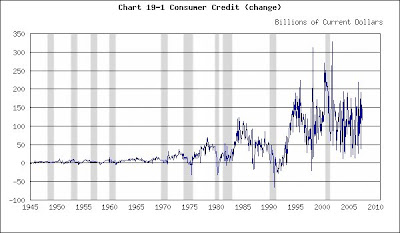
Recessions shaded
Consumer credit is the kind of borrowing we resort to when we “buy on time.” It typically finances consumer-durables expenditures such as automobile purchases. It does not include real-estate mortgage debt, financing or refinancing of any kind.
There’s plenty of noise in the data. The line wobbles like the Richter Scale during a California earthquake. Yet your mind’s eye can see that consumer credit has been growing by $100 billion per month at an annual rate for the past half decade. October’s $56.4 billion is a downward break from that trend, and September’s $38.4 billion was even more anemic. Does the apparent shrinkage signal consumers’ future reluctance to buy? Stay tuned.
On December 10 the Census Bureau reported (http://www.census.gov/csd/qfr/view/qfr_mg.pdf) that manufacturers’ after-tax profits fell to $87.563 billion in the third quarter. Update the chart below in your mind’s eye and you can see the substantial drop in earnings. Profits had been in the $120 billion range through the second quarter. Unlike the consumer credit statistic, this series does not have a lot of noise. A $35 billion plunge is probably a noteworthy event, not a random hiccup in the data.
Manufacturing After-Tax profits
(Click on chart to enlarge)
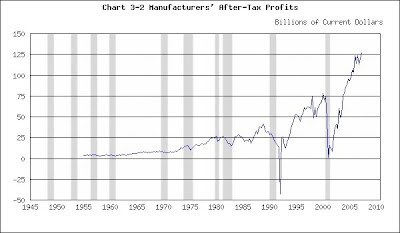
Recessions shaded
At the same time the Census Bureau also reported that manufacturing profit margins fell to 5.67 cents per dollar of sales from over 8 cents in the second quarter. This decline in margins probably generated the overall drop in profits noted above. Strong competitive pressures may have prevented management from raising prices sufficiently to recoup increased costs.
Update the chart below in your mind’s eye. This chart does not have a lot of noise either. A 2-cent decline in margins is a noteworthy event.
Manufacturing Profit Margins in Cents Per Dollar of Sales
(Click on chart to enlarge)
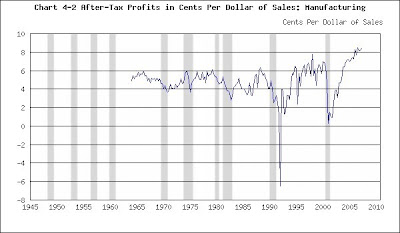
Recessions shaded
Declining profits and profitability (margins) are bad omens for the economy. Together with the deterioration in consumer credit………… Let’s just say they’re cause for concern.
(The charts were taken from http://www.beyourowneconomist.com. [Click on Seminars and then Charts.] Go there for additional charts on the economy and a list of Economic Indicators.)
© 2007 Michael B. Lehmann
While this blog remained preoccupied with the December 7 employment report and the December 11 Federal Reserve rate cut, two other statistics were released to little notice. They should have received more attention because they could be bad omens for consumer demand and corporate profits.
On December 7 the Fed reported (http://www.federalreserve.gov/releases/g19/Current/) that consumer credit grew $4.7 billion in October. (You can obtain this figure from the press release by subtracting September’s outstanding debt - seasonally adjusted – from October’s.) Multiply that number by 12 to put the data on an annual basis. Now compare that $56.4 billion product in your mind’s eye with the series in the chart below.
Consumer Credit
(Click on chart to enlarge)

Recessions shaded
Consumer credit is the kind of borrowing we resort to when we “buy on time.” It typically finances consumer-durables expenditures such as automobile purchases. It does not include real-estate mortgage debt, financing or refinancing of any kind.
There’s plenty of noise in the data. The line wobbles like the Richter Scale during a California earthquake. Yet your mind’s eye can see that consumer credit has been growing by $100 billion per month at an annual rate for the past half decade. October’s $56.4 billion is a downward break from that trend, and September’s $38.4 billion was even more anemic. Does the apparent shrinkage signal consumers’ future reluctance to buy? Stay tuned.
On December 10 the Census Bureau reported (http://www.census.gov/csd/qfr/view/qfr_mg.pdf) that manufacturers’ after-tax profits fell to $87.563 billion in the third quarter. Update the chart below in your mind’s eye and you can see the substantial drop in earnings. Profits had been in the $120 billion range through the second quarter. Unlike the consumer credit statistic, this series does not have a lot of noise. A $35 billion plunge is probably a noteworthy event, not a random hiccup in the data.
Manufacturing After-Tax profits
(Click on chart to enlarge)

Recessions shaded
At the same time the Census Bureau also reported that manufacturing profit margins fell to 5.67 cents per dollar of sales from over 8 cents in the second quarter. This decline in margins probably generated the overall drop in profits noted above. Strong competitive pressures may have prevented management from raising prices sufficiently to recoup increased costs.
Update the chart below in your mind’s eye. This chart does not have a lot of noise either. A 2-cent decline in margins is a noteworthy event.
Manufacturing Profit Margins in Cents Per Dollar of Sales
(Click on chart to enlarge)

Recessions shaded
Declining profits and profitability (margins) are bad omens for the economy. Together with the deterioration in consumer credit………… Let’s just say they’re cause for concern.
(The charts were taken from http://www.beyourowneconomist.com. [Click on Seminars and then Charts.] Go there for additional charts on the economy and a list of Economic Indicators.)
© 2007 Michael B. Lehmann
Tuesday, December 11, 2007
A Quarter of a Point
THE BE YOUR OWN ECONOMIST ® BLOG
The Federal Reserve reduced the federal-funds rate by a quarter-of-a-point today. You can find the Fed’s announcement at http://www.federalreserve.gov/newsevents/press/monetary/20071211a.htm.
The text follows:
“The Federal Open Market Committee decided today to lower its target for the federal funds rate 25 basis points to 4-1/4 percent.
“Incoming information suggests that economic growth is slowing, reflecting the intensification of the housing correction and some softening in business and consumer spending. Moreover, strains in financial markets have increased in recent weeks. Today’s action, combined with the policy actions taken earlier, should help promote moderate growth over time.
“Readings on core inflation have improved modestly this year, but elevated energy and commodity prices, among other factors, may put upward pressure on inflation. In this context, the Committee judges that some inflation risks remain, and it will continue to monitor inflation developments carefully.
“Recent developments, including the deterioration in financial market conditions, have increased the uncertainty surrounding the outlook for economic growth and inflation. The Committee will continue to assess the effects of financial and other developments on economic prospects and will act as needed to foster price stability and sustainable economic growth.
“Voting for the FOMC monetary policy action were: Ben S. Bernanke, Chairman; Timothy F. Geithner, Vice Chairman; Charles L. Evans; Thomas M. Hoenig; Donald L. Kohn; Randall S. Kroszner; Frederic S. Mishkin; William Poole; and Kevin M. Warsh. Voting against was Eric S. Rosengren, who preferred to lower the target for the federal funds rate by 50 basis points at this meeting.
“In a related action, the Board of Governors unanimously approved a 25-basis-point decrease in the discount rate to 4-3/4 percent. In taking this action, the Board approved the requests submitted by the Boards of Directors of the Federal Reserve Banks of New York, Philadelphia, Cleveland, Richmond, Atlanta, Chicago, and St. Louis.”
The news disappointed the stock market. The S&P fell 38 points and the Dow was down 294 at the close. That’s not surprising. The stock market likes falling interest rates, and most investors obviously preferred a deeper cut. Falling interest rates – on investments that are an alternative to stocks - improve stocks’ attractiveness. Other stock sellers may believe that the Fed’s actions reveal the Fed’s failure to appreciate the likelihood of recession. Those sellers bailed out because they fear the Fed will fail to take sufficient corrective action – in the form of interest-rate reductions – to prevent recession.
But that begs the question of whether or not falling interest rates can prevent recession. Here are the issues.
Economists traditionally prescribed an expansionary monetary policy to counteract economic sluggishness. All things being equal, as the economists like to say, business firms invest more in plant, equipment and inventory when interest rates fall. Lower rates facilitate the borrowing that finances capital expenditures, and lower rates encourage business to invest its own funds in capital expansion rather than purchase an interest-earning instrument.
That logic extended to household capital expenditures because lower mortgage rates encouraged residential construction, and rising rates discouraged building. That was especially evident in the 1960s, 1970s and 1980s. Rapid economic expansion in those decades periodically generated inflation and (with the Fed’s encouragement) rising interest rates. Residential construction slumped when rates rose, and did not bounce back until falling inflation and (with the Fed’s connivance) falling interest rates encouraged construction’s recovery. To sum up: Rates down = construction up = economic recovery.
The 2001 recession provides an interesting illustration. Business capital expenditures slumped dramatically, as the chart below illustrates.
Nondefense Capital Goods
(Click on chart to enlarge)
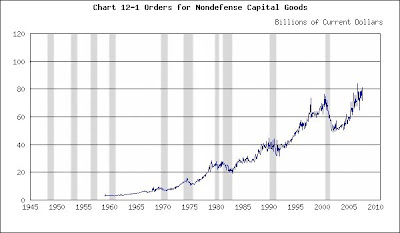
Recessions shaded
Nondefense capital expenditures (everything from Boeings to backhoes) tumbled because of the 2001 dot.com bust. The Fed rode to the rescue, as the next chart shows.
Federal Funds Rate
(Click on chart to enlarge)
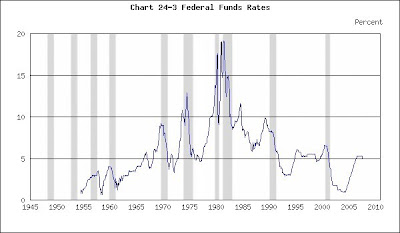
Recessions shaded
The Fed sharply reduced the federal-funds rate in 2001, and you can see that nondefense capital goods began to recover. But the rate cut probably had little to do with that capital-expenditure rebound. Technology had its own imperatives that loomed larger than prevailing interest rates.
Housing Starts
(Click on chart to enlarge)

Recessions shaded
Housing starts are another matter. No one doubts that falling mortgage rates kindled the 2001 – 2005 construction boom. It was a traditional example of the salutary effect of a Fed rate cut upon housing activity. To sum up (once again): Rates down = construction up = economic recovery.
But something unusual happened next. The economy soared, yet there was no inflation. Instead a speculative bubble emerged in the housing market. Then the air began to leak from the bubble and the great housing implosion began. It was an old-fashioned sell-off, akin to the 2000 – 2002 stock-market panic. Real-estate prices fell in an atmosphere of low inflation. The decline bore little similarity to the (inflation-driven, rising interest rate) housing slumps of old.
So the question arises, “If this housing bust is unlike the housing downturns of the past, can the Fed’s traditional rate-cut policy spur recovery?”
We’ll wait and see, but the probable answer is: “Not likely. If rising inflation and rising interest rates didn’t cause the slump, how effectively can falling rates generate recovery?”
(The charts were taken from http://www.beyourowneconomist.com. [Click on Seminars and then Charts.] Go there for additional charts on the economy and a list of Economic Indicators.)
© 2007 Michael B. Lehmann
The Federal Reserve reduced the federal-funds rate by a quarter-of-a-point today. You can find the Fed’s announcement at http://www.federalreserve.gov/newsevents/press/monetary/20071211a.htm.
The text follows:
“The Federal Open Market Committee decided today to lower its target for the federal funds rate 25 basis points to 4-1/4 percent.
“Incoming information suggests that economic growth is slowing, reflecting the intensification of the housing correction and some softening in business and consumer spending. Moreover, strains in financial markets have increased in recent weeks. Today’s action, combined with the policy actions taken earlier, should help promote moderate growth over time.
“Readings on core inflation have improved modestly this year, but elevated energy and commodity prices, among other factors, may put upward pressure on inflation. In this context, the Committee judges that some inflation risks remain, and it will continue to monitor inflation developments carefully.
“Recent developments, including the deterioration in financial market conditions, have increased the uncertainty surrounding the outlook for economic growth and inflation. The Committee will continue to assess the effects of financial and other developments on economic prospects and will act as needed to foster price stability and sustainable economic growth.
“Voting for the FOMC monetary policy action were: Ben S. Bernanke, Chairman; Timothy F. Geithner, Vice Chairman; Charles L. Evans; Thomas M. Hoenig; Donald L. Kohn; Randall S. Kroszner; Frederic S. Mishkin; William Poole; and Kevin M. Warsh. Voting against was Eric S. Rosengren, who preferred to lower the target for the federal funds rate by 50 basis points at this meeting.
“In a related action, the Board of Governors unanimously approved a 25-basis-point decrease in the discount rate to 4-3/4 percent. In taking this action, the Board approved the requests submitted by the Boards of Directors of the Federal Reserve Banks of New York, Philadelphia, Cleveland, Richmond, Atlanta, Chicago, and St. Louis.”
The news disappointed the stock market. The S&P fell 38 points and the Dow was down 294 at the close. That’s not surprising. The stock market likes falling interest rates, and most investors obviously preferred a deeper cut. Falling interest rates – on investments that are an alternative to stocks - improve stocks’ attractiveness. Other stock sellers may believe that the Fed’s actions reveal the Fed’s failure to appreciate the likelihood of recession. Those sellers bailed out because they fear the Fed will fail to take sufficient corrective action – in the form of interest-rate reductions – to prevent recession.
But that begs the question of whether or not falling interest rates can prevent recession. Here are the issues.
Economists traditionally prescribed an expansionary monetary policy to counteract economic sluggishness. All things being equal, as the economists like to say, business firms invest more in plant, equipment and inventory when interest rates fall. Lower rates facilitate the borrowing that finances capital expenditures, and lower rates encourage business to invest its own funds in capital expansion rather than purchase an interest-earning instrument.
That logic extended to household capital expenditures because lower mortgage rates encouraged residential construction, and rising rates discouraged building. That was especially evident in the 1960s, 1970s and 1980s. Rapid economic expansion in those decades periodically generated inflation and (with the Fed’s encouragement) rising interest rates. Residential construction slumped when rates rose, and did not bounce back until falling inflation and (with the Fed’s connivance) falling interest rates encouraged construction’s recovery. To sum up: Rates down = construction up = economic recovery.
The 2001 recession provides an interesting illustration. Business capital expenditures slumped dramatically, as the chart below illustrates.
Nondefense Capital Goods
(Click on chart to enlarge)

Recessions shaded
Nondefense capital expenditures (everything from Boeings to backhoes) tumbled because of the 2001 dot.com bust. The Fed rode to the rescue, as the next chart shows.
Federal Funds Rate
(Click on chart to enlarge)

Recessions shaded
The Fed sharply reduced the federal-funds rate in 2001, and you can see that nondefense capital goods began to recover. But the rate cut probably had little to do with that capital-expenditure rebound. Technology had its own imperatives that loomed larger than prevailing interest rates.
Housing Starts
(Click on chart to enlarge)

Recessions shaded
Housing starts are another matter. No one doubts that falling mortgage rates kindled the 2001 – 2005 construction boom. It was a traditional example of the salutary effect of a Fed rate cut upon housing activity. To sum up (once again): Rates down = construction up = economic recovery.
But something unusual happened next. The economy soared, yet there was no inflation. Instead a speculative bubble emerged in the housing market. Then the air began to leak from the bubble and the great housing implosion began. It was an old-fashioned sell-off, akin to the 2000 – 2002 stock-market panic. Real-estate prices fell in an atmosphere of low inflation. The decline bore little similarity to the (inflation-driven, rising interest rate) housing slumps of old.
So the question arises, “If this housing bust is unlike the housing downturns of the past, can the Fed’s traditional rate-cut policy spur recovery?”
We’ll wait and see, but the probable answer is: “Not likely. If rising inflation and rising interest rates didn’t cause the slump, how effectively can falling rates generate recovery?”
(The charts were taken from http://www.beyourowneconomist.com. [Click on Seminars and then Charts.] Go there for additional charts on the economy and a list of Economic Indicators.)
© 2007 Michael B. Lehmann
Friday, December 7, 2007
94,000……
THE LEHMANN LETTER
This morning the Bureau of Labor Statistics (BLS) reported (http://stats.bls.gov/news.release/empsit.nr0.htm ) that nonfarm payroll employment grew by 94,000 in November.
Here’s the first paragraph of that report:
“Nonfarm payroll employment continued to trend up in November (94,000), andthe unemployment rate held at 4.7 percent, the Bureau of Labor Statistics of theU.S. Department of Labor reported today. Job growth continued in professionaland technical services, health care, and food services. Employment continued todecline in manufacturing and also fell in several housing-related industries,including construction, credit intermediation, and real estate. Average hourlyearnings rose by 8 cents over the month.”
Use the 94,000 job-growth figure to update the chart below in your mind’s eye.
Job Growth
(Click on chart to enlarge)
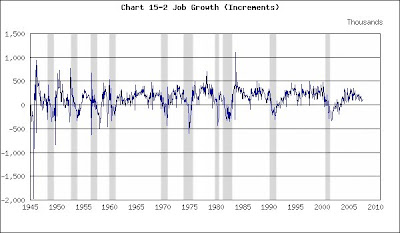
This morning the Bureau of Labor Statistics (BLS) reported (http://stats.bls.gov/news.release/empsit.nr0.htm ) that nonfarm payroll employment grew by 94,000 in November.
Here’s the first paragraph of that report:
“Nonfarm payroll employment continued to trend up in November (94,000), andthe unemployment rate held at 4.7 percent, the Bureau of Labor Statistics of theU.S. Department of Labor reported today. Job growth continued in professionaland technical services, health care, and food services. Employment continued todecline in manufacturing and also fell in several housing-related industries,including construction, credit intermediation, and real estate. Average hourlyearnings rose by 8 cents over the month.”
Use the 94,000 job-growth figure to update the chart below in your mind’s eye.
Job Growth
(Click on chart to enlarge)

Recessions shaded
That’s not a bad number, but you can see the falling trend. The economy is not creating the 150,000 to 200,000 jobs a month as it was a year or two ago, and is nowhere near the 200,000 to 300,000 pace of the late 1990s. The quote above identifies manufacturing, home-construction, mortgage-financing and real estate as areas of job loss.
None of this is surprising. The economy is weakening and everyone is waiting to see whether the slump in housing, and all its attendant sectors and industries, will pull the rest of the economy down with it. Or, perhaps, the economy will perk up and cruise along. So far there is no clear trend in either direction, and this morning's job-growth report does not settle the issue.
(The chart was taken from http://www.beyourowneconomist.com/. [Click on Seminars and then Charts.] Go there for additional charts on the economy and a list of Economic Indicators.)
The Lehmann Letter © 2007 Michael B. Lehmann
That’s not a bad number, but you can see the falling trend. The economy is not creating the 150,000 to 200,000 jobs a month as it was a year or two ago, and is nowhere near the 200,000 to 300,000 pace of the late 1990s. The quote above identifies manufacturing, home-construction, mortgage-financing and real estate as areas of job loss.
None of this is surprising. The economy is weakening and everyone is waiting to see whether the slump in housing, and all its attendant sectors and industries, will pull the rest of the economy down with it. Or, perhaps, the economy will perk up and cruise along. So far there is no clear trend in either direction, and this morning's job-growth report does not settle the issue.
(The chart was taken from http://www.beyourowneconomist.com/. [Click on Seminars and then Charts.] Go there for additional charts on the economy and a list of Economic Indicators.)
The Lehmann Letter © 2007 Michael B. Lehmann
Thursday, December 6, 2007
Sub-Prime Plan
The Lehmann Letter ©
Sub-Prime Plan
This morning’s New York Times ran a story (http://www.nytimes.com/2007/12/06/washington/06debt.html?_r=1&oref=slogin)
on the Bush administration’s sub-prime-mortgage bailout plan. It contained an observation and a quote that do not inspire confidence.
Any plan must spare borrowers with adjustable-rate mortgages from an imminent reset to a rate higher than the borrowers can afford. The reset is postponed to the day when the borrowers are better able to meet their obligations or home prices rise once again to the point that refinancing become possible. If millions of borrowers are potentially eligible, however, there will be efforts to exclude those who can pay under any circumstances – and therefore don’t need assistance - and those who are unable to pay under any circumstances –and therefore should be excluded from eligibility.
Here is the excerpt from The New York Times article.
“Barclays Capital — extrapolating from a similar program recently unveiled in California — estimates that only about 12 percent of all subprime borrowers, or 240,000 homeowners, would get relief.
“From what I’ve heard, I don’t see anything that leads me to believe we will see an increase in loan modifications,” said Eric Halperin, Washington director of the Center for Responsible Lending, a nonprofit group that has studied the subprime problem.”
Moreover, some have asked the obvious question, “Suppose the housing-price decline lasts longer than anticipated or there’s a recession or there’s a steep increase in interest rates, how will the beneficiaries of the plan deal with a reset any time soon?” Others who are meeting their reset obligations question the fairness of helping those who don’t or won’t meet theirs. And so on.
But there’s a larger issue. Our economic system requires profitability and continually expanding demand. Profits are an incentive to produce and continually expanding demand assures profitability. Accordingly mortgage lenders strive to broaden the scope of their operations. When interest rates reach an irreducible minimum, new methods must be found to expand the pool of potential borrowers. That leads to no money down, no income qualification to borrow and a low (adjustable) teaser rate to draw the borrower into the deal.
The entire economy benefitted from these innovations after the 2001 recession as booming real-estate and home-construction markets pulled the economy out of the trough. The Fed did not object because international competition and plenty of excess capacity held prices down. We had asset inflation rather than price inflation, and asset inflation is not in the Fed’s play book. Then the bubble burst and the flaws became apparent.
Debt is not the lubricant that greases the gears, it’s the fuel that powers the engine. We’ve come to rely on this gas guzzler. There’s no other model in reserve.
Sub-Prime Plan
This morning’s New York Times ran a story (http://www.nytimes.com/2007/12/06/washington/06debt.html?_r=1&oref=slogin)
on the Bush administration’s sub-prime-mortgage bailout plan. It contained an observation and a quote that do not inspire confidence.
Any plan must spare borrowers with adjustable-rate mortgages from an imminent reset to a rate higher than the borrowers can afford. The reset is postponed to the day when the borrowers are better able to meet their obligations or home prices rise once again to the point that refinancing become possible. If millions of borrowers are potentially eligible, however, there will be efforts to exclude those who can pay under any circumstances – and therefore don’t need assistance - and those who are unable to pay under any circumstances –and therefore should be excluded from eligibility.
Here is the excerpt from The New York Times article.
“Barclays Capital — extrapolating from a similar program recently unveiled in California — estimates that only about 12 percent of all subprime borrowers, or 240,000 homeowners, would get relief.
“From what I’ve heard, I don’t see anything that leads me to believe we will see an increase in loan modifications,” said Eric Halperin, Washington director of the Center for Responsible Lending, a nonprofit group that has studied the subprime problem.”
Moreover, some have asked the obvious question, “Suppose the housing-price decline lasts longer than anticipated or there’s a recession or there’s a steep increase in interest rates, how will the beneficiaries of the plan deal with a reset any time soon?” Others who are meeting their reset obligations question the fairness of helping those who don’t or won’t meet theirs. And so on.
But there’s a larger issue. Our economic system requires profitability and continually expanding demand. Profits are an incentive to produce and continually expanding demand assures profitability. Accordingly mortgage lenders strive to broaden the scope of their operations. When interest rates reach an irreducible minimum, new methods must be found to expand the pool of potential borrowers. That leads to no money down, no income qualification to borrow and a low (adjustable) teaser rate to draw the borrower into the deal.
The entire economy benefitted from these innovations after the 2001 recession as booming real-estate and home-construction markets pulled the economy out of the trough. The Fed did not object because international competition and plenty of excess capacity held prices down. We had asset inflation rather than price inflation, and asset inflation is not in the Fed’s play book. Then the bubble burst and the flaws became apparent.
Debt is not the lubricant that greases the gears, it’s the fuel that powers the engine. We’ve come to rely on this gas guzzler. There’s no other model in reserve.
Wednesday, December 5, 2007
Productivity
The Lehmann Letter ©
Stocks jumped this morning when the Bureau of Labor Statistics (BLS) announced (http://stats.bls.gov/news.release/prod2.nr0.htm) that third-quarter productivity had surged 6.7%. Use that number to update the chart below in your mind’s eye, and you’ll appreciate the impressive size of this gain. There hasn’t been a jump like that in years.
Productivity
(Click on chart to enlarge)
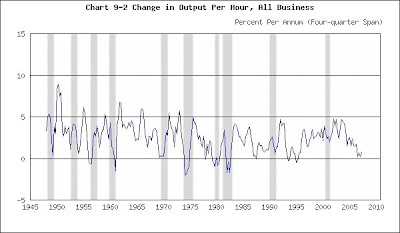
Recessions shaded
Productivity measures the economy’s efficiency: How much output grows for each additional hour of labor employed. (Think of miles per gallon [MPG] as an analogy. An efficient engine travels further - and less expensively - on a gallon of fuel.) Greater output per hour of work indicates that fewer hours were required to complete a task. Since labor must be paid, rising productivity – and falling labor time per unit of output – implies falling costs. And sure enough, the BLS also reported unit labor costs fell 2.0% in the third quarter.
Investors love reports like these because rising productivity and falling costs signal a reduction in inflationary pressures. That means the Fed is more likely to reduce interest rates at its December 11 meeting. Falling interest rates are good for stocks because stock prices rise when investors desert interest-earning assets (with declining yields) in order to purchase stocks.
But before you conclude that the New Economy has taken on new life, consider the following. The BLS report states third-quarter GDP’s rapid rise accounts for most of the productivity gain. Update the chart below with GDP’s 4.9% third-quarter jump, and you’ll note an increase that is almost as impressive as productivity’s surge.
GDP
(Click on chart to enlarge)
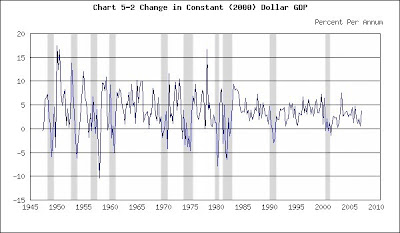
Recessions shaded
The point is: Productivity tends to fluctuate with output. We had good fortune in the third quarter when output and productivity leapt upward. If GDP growth begins to falter as the economy weakens in the months ahead, expect diminishing productivity gains and rising costs. That will constrain the Fed’s freedom of action and investor’s enthusiasm.
(The charts are taken from http://www.beyourowneconomist.com. [Click on Seminars and then Charts.] Go there for additional charts on the economy and a list of economic indicators.)
Stocks jumped this morning when the Bureau of Labor Statistics (BLS) announced (http://stats.bls.gov/news.release/prod2.nr0.htm) that third-quarter productivity had surged 6.7%. Use that number to update the chart below in your mind’s eye, and you’ll appreciate the impressive size of this gain. There hasn’t been a jump like that in years.
Productivity
(Click on chart to enlarge)

Recessions shaded
Productivity measures the economy’s efficiency: How much output grows for each additional hour of labor employed. (Think of miles per gallon [MPG] as an analogy. An efficient engine travels further - and less expensively - on a gallon of fuel.) Greater output per hour of work indicates that fewer hours were required to complete a task. Since labor must be paid, rising productivity – and falling labor time per unit of output – implies falling costs. And sure enough, the BLS also reported unit labor costs fell 2.0% in the third quarter.
Investors love reports like these because rising productivity and falling costs signal a reduction in inflationary pressures. That means the Fed is more likely to reduce interest rates at its December 11 meeting. Falling interest rates are good for stocks because stock prices rise when investors desert interest-earning assets (with declining yields) in order to purchase stocks.
But before you conclude that the New Economy has taken on new life, consider the following. The BLS report states third-quarter GDP’s rapid rise accounts for most of the productivity gain. Update the chart below with GDP’s 4.9% third-quarter jump, and you’ll note an increase that is almost as impressive as productivity’s surge.
GDP
(Click on chart to enlarge)

Recessions shaded
The point is: Productivity tends to fluctuate with output. We had good fortune in the third quarter when output and productivity leapt upward. If GDP growth begins to falter as the economy weakens in the months ahead, expect diminishing productivity gains and rising costs. That will constrain the Fed’s freedom of action and investor’s enthusiasm.
(The charts are taken from http://www.beyourowneconomist.com. [Click on Seminars and then Charts.] Go there for additional charts on the economy and a list of economic indicators.)
Tuesday, December 4, 2007
No Recession Yet
The Lehmann Letter ©
At the beginning of each month The Wall Street Journal publishes an article on the prior month’s auto sales. Today’s story (http://online.wsj.com/article/SB119643941326509603.html?mod=hpp_us_whats_news) carried an interesting quote:
“Auto makers had grown accustomed to industry sales of around 17 million. The industry's overall seasonally adjusted annual selling pace in November was 16.2 million light vehicles, according to Autodata.
“Ford's production cut reflected a "particularly challenging" market environment, said George Pipas, the auto maker's top sales analyst, adding that the nation's economic outlook "contains a high level of uncertainty." Ford expects 2008 total sales to track as low as 15.2 million light vehicles during the first six months of next year, or nearly a million fewer than 2007's expected total, Mr. Pipas said, though he stressed that projection wasn't Ford's finalized full-year forecast.”
Take a look at the following chart to put this information in perspective.
New-Vehicle Sales
(Click on chart to enlarge)
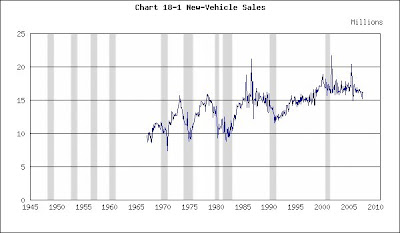
Recessions shaded
You can see why auto sales are of interest. They led the economy into recession in each slump over the past 40 years except for the last one. In 2001 the auto manufacturers kept sales aloft by slashing customers’ financing costs. Since then auto purchases have been on a remarkable plateau. As the quote above said, “Auto makers had grown accustomed to industry sales of around 17 million.”
The article reports a16.2 million annual selling pace in November and tells us that Ford forecasts a 15.2 million rate in the first half of 2008. That’s not bad, and nowhere near a recessionary slump. If that forecast proves correct, auto sales will not drag the economy into recession’s trough.
These sales numbers and projections are important because, as earlier editions of this blog have observed, a slump in residential-construction activity has never been enough to instigate recession. In the past surging inflation constricted consumer confidence and reduced construction and auto activity. Housing AND autos led the way into recession, never housing alone.
Neither housing nor autos slumped in the 2001 recession. A contraction in business capital expenditures led that decline. That’s why yesterday’s Institute for Supply Management (ISM) report on manufacturing activity (known as the Purchasing Managers’ Index) is important. The ISM disclosed that manufacturing continued to expand at an anemic pace of 50.8. (Anything over 50 signals expansion.)
Purchasing Managers’ Index
(Click on chart to enlarge)
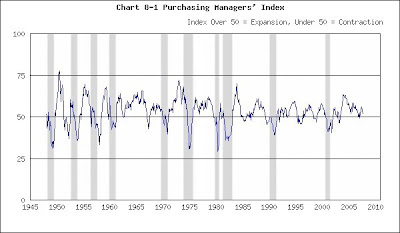
Recessions shaded
The index fell during the 2001 recession and then recovered sharply as manufacturing expanded rapidly. But the rate of expansion has trailed downward over the past few years and is now on the knife’s edge of falling into contraction. It’s tepid, but not yet cold.
Industrial production’s record confirms this.
Industrial Production
(Click on chart to enlarge)
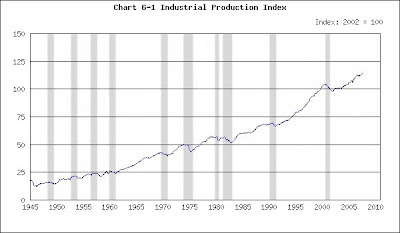
Recessions shaded
Industrial production stumbled in the 2001 recession when business curtailed its expansionary plans. Then it resumed its upward trend, although not at the torrid pace of the late 1990s. The Federal Reserve releases November’s data in ten days. If it replicates the ISM report, there will be no signal that we’re in recession.
The housing debacle is awful, but that’s a single indicator. And most statistics, such as those discussed above, have not yet slumped. We must wait and see.
(The charts are taken from http://www.beyourowneconomist.com. [Click on Seminars and then Charts.] Go there for additional charts on the economy and a list of economic indicators.)
At the beginning of each month The Wall Street Journal publishes an article on the prior month’s auto sales. Today’s story (http://online.wsj.com/article/SB119643941326509603.html?mod=hpp_us_whats_news) carried an interesting quote:
“Auto makers had grown accustomed to industry sales of around 17 million. The industry's overall seasonally adjusted annual selling pace in November was 16.2 million light vehicles, according to Autodata.
“Ford's production cut reflected a "particularly challenging" market environment, said George Pipas, the auto maker's top sales analyst, adding that the nation's economic outlook "contains a high level of uncertainty." Ford expects 2008 total sales to track as low as 15.2 million light vehicles during the first six months of next year, or nearly a million fewer than 2007's expected total, Mr. Pipas said, though he stressed that projection wasn't Ford's finalized full-year forecast.”
Take a look at the following chart to put this information in perspective.
New-Vehicle Sales
(Click on chart to enlarge)

Recessions shaded
You can see why auto sales are of interest. They led the economy into recession in each slump over the past 40 years except for the last one. In 2001 the auto manufacturers kept sales aloft by slashing customers’ financing costs. Since then auto purchases have been on a remarkable plateau. As the quote above said, “Auto makers had grown accustomed to industry sales of around 17 million.”
The article reports a16.2 million annual selling pace in November and tells us that Ford forecasts a 15.2 million rate in the first half of 2008. That’s not bad, and nowhere near a recessionary slump. If that forecast proves correct, auto sales will not drag the economy into recession’s trough.
These sales numbers and projections are important because, as earlier editions of this blog have observed, a slump in residential-construction activity has never been enough to instigate recession. In the past surging inflation constricted consumer confidence and reduced construction and auto activity. Housing AND autos led the way into recession, never housing alone.
Neither housing nor autos slumped in the 2001 recession. A contraction in business capital expenditures led that decline. That’s why yesterday’s Institute for Supply Management (ISM) report on manufacturing activity (known as the Purchasing Managers’ Index) is important. The ISM disclosed that manufacturing continued to expand at an anemic pace of 50.8. (Anything over 50 signals expansion.)
Purchasing Managers’ Index
(Click on chart to enlarge)

Recessions shaded
The index fell during the 2001 recession and then recovered sharply as manufacturing expanded rapidly. But the rate of expansion has trailed downward over the past few years and is now on the knife’s edge of falling into contraction. It’s tepid, but not yet cold.
Industrial production’s record confirms this.
Industrial Production
(Click on chart to enlarge)

Recessions shaded
Industrial production stumbled in the 2001 recession when business curtailed its expansionary plans. Then it resumed its upward trend, although not at the torrid pace of the late 1990s. The Federal Reserve releases November’s data in ten days. If it replicates the ISM report, there will be no signal that we’re in recession.
The housing debacle is awful, but that’s a single indicator. And most statistics, such as those discussed above, have not yet slumped. We must wait and see.
(The charts are taken from http://www.beyourowneconomist.com. [Click on Seminars and then Charts.] Go there for additional charts on the economy and a list of economic indicators.)
Monday, December 3, 2007
December Publication Schedule & Web Sources
The Lehmann Letter ©
Here’s December’s economic-indicator publication schedule, followed by a list of web sources. Future postings will discuss these indicators.
You can use the WEB SOURCES listing to find the data on your own and read the accompanying press release. The addresses take you to the source’s home page and the steps tell you how to navigate the site. That way (rather than provide a direct link to the data) you can become familiar with these sites and find additional information on your own.
(P.S. ISM’s Purchasing Managers’ Index was out today at 50.8 More on that tomorrow,)
PUBLICATION SCHEDULE
December 2007
Source (* below)…………………Series Description…………………Day & Date
Quarterly Data
BLS………………………………….Productivity & costs…………………Wed, 5th
Census……………………………..Manufacturing profits………..……Mon, 10th
BEA…………………………………GDP………………………….….............Thu, 20th
BEA…………………………………Corporate profits……………………..Thu, 20th
BEA……………………………..….International transactions……….Mon, 17th
Monthly Data
ISM…………………………………Purchasing managers’ index…....Mon, 3rd
BLS…………………………………Employment……………………………Fri, 7th
Fed…………………………………Consumer credit………………………Fri, 7th
Census…………………………….Balance of trade………………………Wed, 12th
BLS…………………………………Producer prices………………………Thu, 13th
Census……………………………Retail trade……………………………..Thu, 13th
Census……………………………Inventories……………………………..Thu, 13th
BLS…………………………………Consumer prices……………………..Fri, 14th
Fed…………………………………Industrial production……………...Fri, 14th
Fed…………………………………Capacity utilization………………….Fri, 14th
Census…………………………….Housing starts………………………...Tue, 18th
BEA………………………………..Personal income………………………Fri, 21st
Conf Bd…………………………..Economic Indicators……………….Thu, 20th
Census…………………………...Capital goods…………………………..Thu, 27th
Conf Bd…………………….…….Consumer confidence………………Thu, 27th
Census……………………………New-home sales……………………….Fri, 28th
NAR……………………………….Existing-home sales…………….…..Mon, 31st
* BEA = Bureau of Economic Analysis of the U.S. Department of Commerce
* Census = U.S. Bureau of the Census
* Conf Bd = Conference Board
* Fed = Federal Reserve System
* ISM = Institute for Supply Management
* NAR = National Association of Realtors
WEB SOURCES
Quarterly
Manufacturers’ After-tax Profits
http://www.census.gov/
Step 1: Click on "Economic Indicators" in the lower right
Step 2: Click on "PDF" on the left under "Quarterly Financial Report - Manufacturing, Mining and Trade"
Step 3: Scroll down to Table 2 and find after-tax profits for all manufacturing corporation
Labor Productivity & Unit Labor Costs
http://stats.bls.gov
Step 1: Click on “Productivity and Costs” under “Productivity” in left-hand menu bar
Step 2: Click on (HTML) following “Productivity and Costs” under "Economic News Releases:"
Step 3: Click on “Table 1. Business sector"
Step 4: Obtain the most recent quarterly index values for "Output per hour of all persons" and "Unit labor costs" and then scroll down and obtain their "Percent change from previous quarter at annual rate"
Gross Domestic Product
http://www.bea.gov/
Step 1: Click on "Gross Domestic Product" under "National"
Step 2: Click on "National Income and Product Accounts Tables" under "Gross Domestic Product (GDP)"
Step 3: Click on "list of all NIPA Tables"
Step 4: Click on "Table 1.1.6. Real Gross Domestic Product..." and "Table 1.1.1. Percent Change..."
Step 5: Scroll down to line 1 in both tables and go to the last column on the right
After-tax Corporate Profits
http://www.bea.gov/
Step 1: Click on "Gross Domestic Product" under "National"
Step 2: Click on "National Income and Product Accounts Tables" under "Gross Domestic Product (GDP)"
Step 3: Click on "list of all NIPA Tables"
Step 4: Click on "Table 1.12. National Income by Type of Income (A) (Q)"
Step 5: Scroll down to line 46 and go to the last column on the right
International Transactions
http://www.bea.gov
Step 1: Click on "Balance of Payments" under "International"
Step 2: Click on "Detailed estimates"
Step 3: Click on “Table 1. U.S. International Transactions"
Step 4: See lines 72, 74 & 77
Monthly
Institute For Supply Management Index
http://www.ism.ws/
Step 1: Click on "ISM Report on Business" in left-hand menu bar
Step 2: Click on “Latest Manufacturing ROB” and find the latest PMI
Employment Data
(Total Non-farm Payroll Employment)
(Unemployment Rate)
(Manufacturing Workweek)
http://stats.bls.gov/
Step 1: Click on “National Employment” under “Employment & Unemployment” in right-hand menu bar
Step 2: Click on (HTML) following “Employment Situation Summary” under "Economic News Releases"
Step 3: Click on “Employment Situation Summary” under “Table of Contents”
Step 4: Scroll down to Table A and find the unemployment rate for all workers in the latest month, the change in nonfarm employment in the last column and manufacturing hours of work for the latest month
Consumer Credit
http://www.federalreserve.gov/
Step 1: Click on "All Statistical Releases" under "Recent Statistical Releases" and then click on "Consumer credit -- G19" under "Household Finance" in the upper right
Step 2: Click on "Current Release"
Step 3: Go to "Amount ... billions of dollars" and subtract previous month from current month & multiply by 12 to obtain seasonally adjusted dollar amount at annual rate
Balance of Trade
http://www.census.gov/
Step 1: Click on "Economic Indicators" in the lower right
Step 2: Click on "PDF" on the left under "U.S. International Trade in Goods and Services"
Producer Prices
http://stats.bls.gov/
Step 1: Click on “Producer Price Indexes” under “Inflation & Consumer Spending” in left-hand menu bar
Step 2: Note "Finished goods" under "Latest Numbers" in upper right and multiply by 12 to put the data on an annual basis
Retail Trade
http://www.census.gov/
Step 1: Click on "Economic Indicators" in the lower right
Step 2: Scroll down to "Advance Monthly Sales for Retail and Food Services" and click on "HTML" on the left under "Current Press Release"
Inventories, Sales & Inventory/Sales Ratio
http://www.census.gov/
Step 1: Click on "Economic Indicators" in the lower right
Step 2: Click on "HTML" on the left under "Manufacturing and Trade Inventories and Sales"
Step 3: Scroll down to Table 1 and subtract previous month's inventories from latest month's and multiply by 12 to obtain inventory change, and then obtain the most recent inventory/sales ratio
Consumer Price Index
http://stats.bls.gov/
Step 1: Click on “Consumer Price Index” under “Inflation & Consumer Spending” in left-hand menu bar
Step 2: Note "CPI-U..." at the top under "Latest Numbers" in upper right and multiply "SA" by 12 to put the data on an annual basis
Industrial Production & Capacity Utilization
http://www.federalreserve.gov/
Step 1: Click on "All Statistical Releases" under "Recent Statistical Releases" and then click on "Industrial Production and Capacity Utilization" under "Principal Economic Indicators" in the upper left
Step 2: Click on "Current Monthly Release"
Step 3: Find the latest monthly data in the table next to "Total index" and "Total industry"
Housing Starts
http://www.census.gov/
Step 1: Click on "Economic Indicators" in the lower right
Step 2: Click on "PDF" on the left under "Current Press Release" under "Housing Starts/Building Permits"
Step 3: Scroll down to "Housing Starts"
Personal Income
http://www.bea.gov/
Step 1: Click on "Gross Domestic Product" under "National"
Step 2: Click on "National Income and Product Accounts Tables" under "Gross Domestic Product (GDP)"
Step 3: Click on "list of all NIPA Tables"
Step 4: Click on "Table 2.6 Personal Income..."
Step 5: Scroll down to line 1
Index of Leading Economic Indicators
http://www.conference-board.org/
Step 1: Click on "Economics" in the left-hand menu bar
Step 2: Click on "Economic Indicators" under "Economics" in the left-hand menu bar
Step 3: Click on link under "U.S. Leading Indicators"
Business Capital Expenditures
(Nondefense Capital Goods)
http://www.census.gov/
Step 1: Click on "Economic Indicators" in the lower right
Step 2: Click on "PDF" on the left under "Advance Report on Durable Goods Manufacturers' Shipments and Orders"
Step 3: Scroll down to Table 1 and find new orders for nondefense capital goods near the bottom
Consumer Confidence
http://www.conference-board.org/
Step 1: Click on the "Economics" in the left-hand menu bar
Step 2: Click on "Economic Indicators" under "Economics" in the left-hand menu bar
Step 3: Click on link under "Consumer Confidence Index"
New-Home Sales
http://www.census.gov/
Step 1: Click on "Economic Indicators" in the lower right
Step 2: Click on "PDF" on the left under "Current Press Release" under "New Home Sales"
Existing-Home Sales
http://www.realtor.org/
Step 1: Click on "Research" in the left-hand menu bar
Step 2: Find "Existing-Home Sales" under "Housing Indicators"
Here’s December’s economic-indicator publication schedule, followed by a list of web sources. Future postings will discuss these indicators.
You can use the WEB SOURCES listing to find the data on your own and read the accompanying press release. The addresses take you to the source’s home page and the steps tell you how to navigate the site. That way (rather than provide a direct link to the data) you can become familiar with these sites and find additional information on your own.
(P.S. ISM’s Purchasing Managers’ Index was out today at 50.8 More on that tomorrow,)
PUBLICATION SCHEDULE
December 2007
Source (* below)…………………Series Description…………………Day & Date
Quarterly Data
BLS………………………………….Productivity & costs…………………Wed, 5th
Census……………………………..Manufacturing profits………..……Mon, 10th
BEA…………………………………GDP………………………….….............Thu, 20th
BEA…………………………………Corporate profits……………………..Thu, 20th
BEA……………………………..….International transactions……….Mon, 17th
Monthly Data
ISM…………………………………Purchasing managers’ index…....Mon, 3rd
BLS…………………………………Employment……………………………Fri, 7th
Fed…………………………………Consumer credit………………………Fri, 7th
Census…………………………….Balance of trade………………………Wed, 12th
BLS…………………………………Producer prices………………………Thu, 13th
Census……………………………Retail trade……………………………..Thu, 13th
Census……………………………Inventories……………………………..Thu, 13th
BLS…………………………………Consumer prices……………………..Fri, 14th
Fed…………………………………Industrial production……………...Fri, 14th
Fed…………………………………Capacity utilization………………….Fri, 14th
Census…………………………….Housing starts………………………...Tue, 18th
BEA………………………………..Personal income………………………Fri, 21st
Conf Bd…………………………..Economic Indicators……………….Thu, 20th
Census…………………………...Capital goods…………………………..Thu, 27th
Conf Bd…………………….…….Consumer confidence………………Thu, 27th
Census……………………………New-home sales……………………….Fri, 28th
NAR……………………………….Existing-home sales…………….…..Mon, 31st
* BEA = Bureau of Economic Analysis of the U.S. Department of Commerce
* Census = U.S. Bureau of the Census
* Conf Bd = Conference Board
* Fed = Federal Reserve System
* ISM = Institute for Supply Management
* NAR = National Association of Realtors
WEB SOURCES
Quarterly
Manufacturers’ After-tax Profits
http://www.census.gov/
Step 1: Click on "Economic Indicators" in the lower right
Step 2: Click on "PDF" on the left under "Quarterly Financial Report - Manufacturing, Mining and Trade"
Step 3: Scroll down to Table 2 and find after-tax profits for all manufacturing corporation
Labor Productivity & Unit Labor Costs
http://stats.bls.gov
Step 1: Click on “Productivity and Costs” under “Productivity” in left-hand menu bar
Step 2: Click on (HTML) following “Productivity and Costs” under "Economic News Releases:"
Step 3: Click on “Table 1. Business sector"
Step 4: Obtain the most recent quarterly index values for "Output per hour of all persons" and "Unit labor costs" and then scroll down and obtain their "Percent change from previous quarter at annual rate"
Gross Domestic Product
http://www.bea.gov/
Step 1: Click on "Gross Domestic Product" under "National"
Step 2: Click on "National Income and Product Accounts Tables" under "Gross Domestic Product (GDP)"
Step 3: Click on "list of all NIPA Tables"
Step 4: Click on "Table 1.1.6. Real Gross Domestic Product..." and "Table 1.1.1. Percent Change..."
Step 5: Scroll down to line 1 in both tables and go to the last column on the right
After-tax Corporate Profits
http://www.bea.gov/
Step 1: Click on "Gross Domestic Product" under "National"
Step 2: Click on "National Income and Product Accounts Tables" under "Gross Domestic Product (GDP)"
Step 3: Click on "list of all NIPA Tables"
Step 4: Click on "Table 1.12. National Income by Type of Income (A) (Q)"
Step 5: Scroll down to line 46 and go to the last column on the right
International Transactions
http://www.bea.gov
Step 1: Click on "Balance of Payments" under "International"
Step 2: Click on "Detailed estimates"
Step 3: Click on “Table 1. U.S. International Transactions"
Step 4: See lines 72, 74 & 77
Monthly
Institute For Supply Management Index
http://www.ism.ws/
Step 1: Click on "ISM Report on Business" in left-hand menu bar
Step 2: Click on “Latest Manufacturing ROB” and find the latest PMI
Employment Data
(Total Non-farm Payroll Employment)
(Unemployment Rate)
(Manufacturing Workweek)
http://stats.bls.gov/
Step 1: Click on “National Employment” under “Employment & Unemployment” in right-hand menu bar
Step 2: Click on (HTML) following “Employment Situation Summary” under "Economic News Releases"
Step 3: Click on “Employment Situation Summary” under “Table of Contents”
Step 4: Scroll down to Table A and find the unemployment rate for all workers in the latest month, the change in nonfarm employment in the last column and manufacturing hours of work for the latest month
Consumer Credit
http://www.federalreserve.gov/
Step 1: Click on "All Statistical Releases" under "Recent Statistical Releases" and then click on "Consumer credit -- G19" under "Household Finance" in the upper right
Step 2: Click on "Current Release"
Step 3: Go to "Amount ... billions of dollars" and subtract previous month from current month & multiply by 12 to obtain seasonally adjusted dollar amount at annual rate
Balance of Trade
http://www.census.gov/
Step 1: Click on "Economic Indicators" in the lower right
Step 2: Click on "PDF" on the left under "U.S. International Trade in Goods and Services"
Producer Prices
http://stats.bls.gov/
Step 1: Click on “Producer Price Indexes” under “Inflation & Consumer Spending” in left-hand menu bar
Step 2: Note "Finished goods" under "Latest Numbers" in upper right and multiply by 12 to put the data on an annual basis
Retail Trade
http://www.census.gov/
Step 1: Click on "Economic Indicators" in the lower right
Step 2: Scroll down to "Advance Monthly Sales for Retail and Food Services" and click on "HTML" on the left under "Current Press Release"
Inventories, Sales & Inventory/Sales Ratio
http://www.census.gov/
Step 1: Click on "Economic Indicators" in the lower right
Step 2: Click on "HTML" on the left under "Manufacturing and Trade Inventories and Sales"
Step 3: Scroll down to Table 1 and subtract previous month's inventories from latest month's and multiply by 12 to obtain inventory change, and then obtain the most recent inventory/sales ratio
Consumer Price Index
http://stats.bls.gov/
Step 1: Click on “Consumer Price Index” under “Inflation & Consumer Spending” in left-hand menu bar
Step 2: Note "CPI-U..." at the top under "Latest Numbers" in upper right and multiply "SA" by 12 to put the data on an annual basis
Industrial Production & Capacity Utilization
http://www.federalreserve.gov/
Step 1: Click on "All Statistical Releases" under "Recent Statistical Releases" and then click on "Industrial Production and Capacity Utilization" under "Principal Economic Indicators" in the upper left
Step 2: Click on "Current Monthly Release"
Step 3: Find the latest monthly data in the table next to "Total index" and "Total industry"
Housing Starts
http://www.census.gov/
Step 1: Click on "Economic Indicators" in the lower right
Step 2: Click on "PDF" on the left under "Current Press Release" under "Housing Starts/Building Permits"
Step 3: Scroll down to "Housing Starts"
Personal Income
http://www.bea.gov/
Step 1: Click on "Gross Domestic Product" under "National"
Step 2: Click on "National Income and Product Accounts Tables" under "Gross Domestic Product (GDP)"
Step 3: Click on "list of all NIPA Tables"
Step 4: Click on "Table 2.6 Personal Income..."
Step 5: Scroll down to line 1
Index of Leading Economic Indicators
http://www.conference-board.org/
Step 1: Click on "Economics" in the left-hand menu bar
Step 2: Click on "Economic Indicators" under "Economics" in the left-hand menu bar
Step 3: Click on link under "U.S. Leading Indicators"
Business Capital Expenditures
(Nondefense Capital Goods)
http://www.census.gov/
Step 1: Click on "Economic Indicators" in the lower right
Step 2: Click on "PDF" on the left under "Advance Report on Durable Goods Manufacturers' Shipments and Orders"
Step 3: Scroll down to Table 1 and find new orders for nondefense capital goods near the bottom
Consumer Confidence
http://www.conference-board.org/
Step 1: Click on the "Economics" in the left-hand menu bar
Step 2: Click on "Economic Indicators" under "Economics" in the left-hand menu bar
Step 3: Click on link under "Consumer Confidence Index"
New-Home Sales
http://www.census.gov/
Step 1: Click on "Economic Indicators" in the lower right
Step 2: Click on "PDF" on the left under "Current Press Release" under "New Home Sales"
Existing-Home Sales
http://www.realtor.org/
Step 1: Click on "Research" in the left-hand menu bar
Step 2: Find "Existing-Home Sales" under "Housing Indicators"
Thursday, November 29, 2007
Bad-News Good-News Joke
The Lehmann Letter ©
This week’s developments have been a good-news bad-news joke in reverse. The bad news hits, and then the stock market rises.
Yesterday Fed Vice Chairman Donald Kohn, in a speech before the Council on Foreign Relations (http://www.federalreserve.gov/newsevents/speech/kohn20071128a.htm), said:
“To be sure, lowering interest rates to keep the economy on an even keel when adverse financial market developments occur will reduce the penalty incurred by some people who exercised poor judgment. But these people are still bearing the costs of their decisions and we should not hold the economy hostage to teach a small segment of the population a lesson.”
These words convinced investors that the Fed would not hold the economy hostage by maintaining high interest rates. The prospects of further rate cuts powered yesterday’s outstanding stock-market rally, which followed immediately upon Monday’s strong gains.
But we should all keep in mind that Mr. Kohn made his remarks because he believes the economy is losing strength. Yesterday the Fed also released its Beige Book economic survey (http://www.federalreserve.gov/fomc/beigebook/2007/20071128/default.htm), whose summary began with the words:
“Reports from the twelve Federal Reserve Districts suggest that the national economy continued to expand during the survey period of October through mid-November but at a reduced pace compared with the previous survey period. Among Districts, seven reported a slower pace of economic activity while the remainder generally pointed to modest expansion or mixed conditions.”
The economy continues to expand, but at a reduced rate, and 7 of the 12 Federal Reserve districts reported a slower pace of economic activity. That looks like a turning point.
Today's releases reinforce the notion of a turning point.
The Commerce Department’s Bureau of Economic analysis reported this morning that GDP grew 4.9% in the third quarter: http://www.bea.gov/newsreleases/national/gdp/2007/gdp307p.htm.
GDP
(Click on chart to enlarge)

Recessions shaded
If you update the chart with that number, you’ll find nothing disappointing.
Today’s other release is not so positive. The Census Bureau reported (http://www.census.gov/const/newressales.pdf) 728,000 new homes sold in October.
New Home Sales
(Click on chart to enlarge)
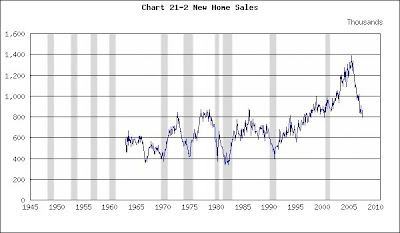
(The charts are taken from http://www.beyourowneconomist.com. [Click on Seminars and then Charts.] Go there for additional charts on the economy and a list of economic indicators.)
This week’s developments have been a good-news bad-news joke in reverse. The bad news hits, and then the stock market rises.
Yesterday Fed Vice Chairman Donald Kohn, in a speech before the Council on Foreign Relations (http://www.federalreserve.gov/newsevents/speech/kohn20071128a.htm), said:
“To be sure, lowering interest rates to keep the economy on an even keel when adverse financial market developments occur will reduce the penalty incurred by some people who exercised poor judgment. But these people are still bearing the costs of their decisions and we should not hold the economy hostage to teach a small segment of the population a lesson.”
These words convinced investors that the Fed would not hold the economy hostage by maintaining high interest rates. The prospects of further rate cuts powered yesterday’s outstanding stock-market rally, which followed immediately upon Monday’s strong gains.
But we should all keep in mind that Mr. Kohn made his remarks because he believes the economy is losing strength. Yesterday the Fed also released its Beige Book economic survey (http://www.federalreserve.gov/fomc/beigebook/2007/20071128/default.htm), whose summary began with the words:
“Reports from the twelve Federal Reserve Districts suggest that the national economy continued to expand during the survey period of October through mid-November but at a reduced pace compared with the previous survey period. Among Districts, seven reported a slower pace of economic activity while the remainder generally pointed to modest expansion or mixed conditions.”
The economy continues to expand, but at a reduced rate, and 7 of the 12 Federal Reserve districts reported a slower pace of economic activity. That looks like a turning point.
Today's releases reinforce the notion of a turning point.
The Commerce Department’s Bureau of Economic analysis reported this morning that GDP grew 4.9% in the third quarter: http://www.bea.gov/newsreleases/national/gdp/2007/gdp307p.htm.
GDP
(Click on chart to enlarge)

Recessions shaded
If you update the chart with that number, you’ll find nothing disappointing.
Today’s other release is not so positive. The Census Bureau reported (http://www.census.gov/const/newressales.pdf) 728,000 new homes sold in October.
New Home Sales
(Click on chart to enlarge)

Recessions shaded
When you update this chart you can see that 728,000 maintains the downward trend and that sales are now half their earlier peak. Notice that sales losses of that magnitude forecast earlier recessions. Also, sales are now lower than they were before the current boom began at the conclusion of the 2001 recession. All those gains have been lost.
What to make of these conflicting reports? You can sort it out if you keep in mind that the (good) GDP report was a broad-brush picture of the economy from July through September, while October’s (bad) home-sales figure focuses on a leading indicator. That’s consistent with a turning point. (And a good-news, bad-news story.)
When you update this chart you can see that 728,000 maintains the downward trend and that sales are now half their earlier peak. Notice that sales losses of that magnitude forecast earlier recessions. Also, sales are now lower than they were before the current boom began at the conclusion of the 2001 recession. All those gains have been lost.
What to make of these conflicting reports? You can sort it out if you keep in mind that the (good) GDP report was a broad-brush picture of the economy from July through September, while October’s (bad) home-sales figure focuses on a leading indicator. That’s consistent with a turning point. (And a good-news, bad-news story.)
(The charts are taken from http://www.beyourowneconomist.com. [Click on Seminars and then Charts.] Go there for additional charts on the economy and a list of economic indicators.)
Wednesday, November 28, 2007
The Stock Market’s Up, But….
The Lehmann Letter ©
It’s 10am Pacific Time (1pm Eastern Time) and the S&P is already up 25 points and the Dow is up over 250, spurred on by interest-rate-cut hopes and falling oil prices: http://money.cnn.com/2007/11/28/markets/markets_1045/index.htm?postversion=2007112810. And that follows yesterday’s big gains. What happened to that stock-market correction and all those fears of recession?
The fears are alive and well, if you look at the rest of the day’s stories.
The National Association of Realtors (NAR) reported today that existing-home sales fell to just below 5 million for the first time since the post-9/11 housing boom began: http://www.realtor.org/press_room/news_releases/2007/ehs_oct07_mixed_results.html. (The NAR also reported prices down 5% from a year ago.)
Existing-Home Sales
(Click on chart to enlarge)
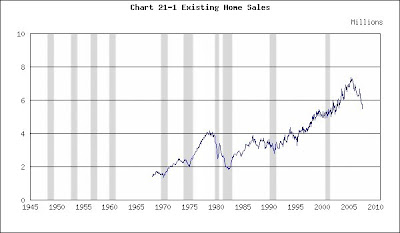
Recessions shaded
If you update this chart in your mind’s eye by extending the line below 5 million, you can see home sales are back where they were in the late 1990s and off by about 2 million from their peak. How much further will they fall?
You can see that home sales were cut in half during the back-to-back 1980 and 1981 recessions. Nothing that severe has happened since then. An equivalent drop today would reduce sales to 3.5 million. Scary.
The Census Bureau also reported today on durable-goods orders – new orders for everything from autos to aircraft: http://www.census.gov/indicator/www/m3/adv/pdf/durgd.pdf. They were down as well. A slice of that total, known as new orders for nondefense capital goods, is of interest. This figure represents new business orders for machinery and equipment.
New Orders for Nondefense Capital Goods
(Click on chart to enlarge)

The chart shows that new orders for nondefense capital goods peaked at a little more than 70 million at the height of the dot.com boom before tumbling into the trough of the 2001 recession. Today’s report shows that new orders have been flat at just over 70 million for the past several months. If that signals a new peak, it’s a bad omen. New orders will have barely exceeded their previous high before heading south again. In all previous recoveries from recession, new orders climbed to new heights. If today’s flat spot signals a new peak, the recent expansion will have been weak.
In a final bit of bad news, yesterday the Conference Board reported that its consumer-confidence index had fallen to 87.3: http://www.conference-board.org/economics/ConsumerConfidence.cfm.
Consumer Confidence
(Click on chart to enlarge)
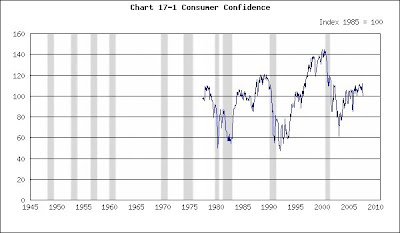
Recessions shaded
It was over 100 not too long ago. Consumers have been bombarded with bad news on housing and fuel prices, and are registering their discomfort. They’re not optimistic about the path ahead.
They’re probably correct.
(The charts are taken from http://www.beyourowneconomist.com. [Click on Seminars and then Charts.] Go there for additional charts on the economy and a list of economic indicators.)
It’s 10am Pacific Time (1pm Eastern Time) and the S&P is already up 25 points and the Dow is up over 250, spurred on by interest-rate-cut hopes and falling oil prices: http://money.cnn.com/2007/11/28/markets/markets_1045/index.htm?postversion=2007112810. And that follows yesterday’s big gains. What happened to that stock-market correction and all those fears of recession?
The fears are alive and well, if you look at the rest of the day’s stories.
The National Association of Realtors (NAR) reported today that existing-home sales fell to just below 5 million for the first time since the post-9/11 housing boom began: http://www.realtor.org/press_room/news_releases/2007/ehs_oct07_mixed_results.html. (The NAR also reported prices down 5% from a year ago.)
Existing-Home Sales
(Click on chart to enlarge)

Recessions shaded
If you update this chart in your mind’s eye by extending the line below 5 million, you can see home sales are back where they were in the late 1990s and off by about 2 million from their peak. How much further will they fall?
You can see that home sales were cut in half during the back-to-back 1980 and 1981 recessions. Nothing that severe has happened since then. An equivalent drop today would reduce sales to 3.5 million. Scary.
The Census Bureau also reported today on durable-goods orders – new orders for everything from autos to aircraft: http://www.census.gov/indicator/www/m3/adv/pdf/durgd.pdf. They were down as well. A slice of that total, known as new orders for nondefense capital goods, is of interest. This figure represents new business orders for machinery and equipment.
New Orders for Nondefense Capital Goods
(Click on chart to enlarge)

The chart shows that new orders for nondefense capital goods peaked at a little more than 70 million at the height of the dot.com boom before tumbling into the trough of the 2001 recession. Today’s report shows that new orders have been flat at just over 70 million for the past several months. If that signals a new peak, it’s a bad omen. New orders will have barely exceeded their previous high before heading south again. In all previous recoveries from recession, new orders climbed to new heights. If today’s flat spot signals a new peak, the recent expansion will have been weak.
In a final bit of bad news, yesterday the Conference Board reported that its consumer-confidence index had fallen to 87.3: http://www.conference-board.org/economics/ConsumerConfidence.cfm.
Consumer Confidence
(Click on chart to enlarge)

Recessions shaded
It was over 100 not too long ago. Consumers have been bombarded with bad news on housing and fuel prices, and are registering their discomfort. They’re not optimistic about the path ahead.
They’re probably correct.
(The charts are taken from http://www.beyourowneconomist.com. [Click on Seminars and then Charts.] Go there for additional charts on the economy and a list of economic indicators.)
Tuesday, November 27, 2007
A Conversation with Paul Otellini
The Lehmann Letter ©
Yesterday evening I was fortunate to attend a public conversation with Paul Otellini, President and CEO of Intel and a former student of mine at the University of San Francisco. Mr. Otellini graduated in 1972 and I’ve been pleased to follow his career to the top of one of America’s great firms. He spoke at USF at the Invitation of USF’s Center for the Pacific Rim.
The questions and conversation were wide ranging and I’d like to briefly touch upon one aspect of the discussion relevant to this blog: The future of the American economy. In response to a question about where the U.S. is today, Mr. Otellini drew an analogy with Great Britain at the end of the nineteenth century. At that time the sun never set on the British Empire and Britain was still “the workshop of the world,” the world’s greatest manufacturer and exporter of manufactures. But Germany and the United States became effective competitors and drove Britain out of international markets for steel, electrical equipment and some kinds of machinery and chemicals. German firms already predominated in Britain’s home market for industrial dyes. Then America took the technological lead and Britain never regained it. Britain today is an affluent and comfortable first-world nation, but no longer an industrial powerhouse.
Mr. Otellini sees the U.S. today in circumstances similar to Britain a century ago. He spoke authoritatively, buttressed with vivid anecdotes drawn from his own experience, of China’s drive for technological excellence and achievement. China’s emphasis on math and science is stunning, as is the number of engineers it graduates. Its efforts at primary and secondary education are likewise prodigious and successful. Its best and brightest still go here for graduate school training, but how long can that last? Meanwhile those students return home to build a world leader.
At the same time the U.S., at least with reference to its public policy, is not doing much. Our best are still the world’s best, but that’s the cream of the crop. Our bench is not deep. Having said that, Mr. Otellini gives credit where credit is due. No one knew better than Intel what a threat the Japanese were in the 1980s to the U.S. semiconductor industry. Yet in the 1990s Silicon Valley, Intel’s microprocessor and Microsoft’s software led the world in the personal computer and internet revolution, while Japan fell into a slump. That happened because we had the innovators. Maybe this story will be told again with respect to the U.S. and China.
Maybe…. But Mr. Otellini’s description of the concerted effort China is making on so many levels should give cause for concern. If it’s important for American industry to maintain leadership, Mr. Otellini ‘s remarks last night implored us to wake up.
(By the way and along the way, Mr. Otellini mentioned the late Alfred Chandler’s Scale and Scope as having an impact on his career and therefore Intel’s future. I also recommend it for an historical account of the development of the giant industrial enterprise, and how America’s and Germany’s business innovations helped those countries take the industrial lead from Britain.)
Yesterday evening I was fortunate to attend a public conversation with Paul Otellini, President and CEO of Intel and a former student of mine at the University of San Francisco. Mr. Otellini graduated in 1972 and I’ve been pleased to follow his career to the top of one of America’s great firms. He spoke at USF at the Invitation of USF’s Center for the Pacific Rim.
The questions and conversation were wide ranging and I’d like to briefly touch upon one aspect of the discussion relevant to this blog: The future of the American economy. In response to a question about where the U.S. is today, Mr. Otellini drew an analogy with Great Britain at the end of the nineteenth century. At that time the sun never set on the British Empire and Britain was still “the workshop of the world,” the world’s greatest manufacturer and exporter of manufactures. But Germany and the United States became effective competitors and drove Britain out of international markets for steel, electrical equipment and some kinds of machinery and chemicals. German firms already predominated in Britain’s home market for industrial dyes. Then America took the technological lead and Britain never regained it. Britain today is an affluent and comfortable first-world nation, but no longer an industrial powerhouse.
Mr. Otellini sees the U.S. today in circumstances similar to Britain a century ago. He spoke authoritatively, buttressed with vivid anecdotes drawn from his own experience, of China’s drive for technological excellence and achievement. China’s emphasis on math and science is stunning, as is the number of engineers it graduates. Its efforts at primary and secondary education are likewise prodigious and successful. Its best and brightest still go here for graduate school training, but how long can that last? Meanwhile those students return home to build a world leader.
At the same time the U.S., at least with reference to its public policy, is not doing much. Our best are still the world’s best, but that’s the cream of the crop. Our bench is not deep. Having said that, Mr. Otellini gives credit where credit is due. No one knew better than Intel what a threat the Japanese were in the 1980s to the U.S. semiconductor industry. Yet in the 1990s Silicon Valley, Intel’s microprocessor and Microsoft’s software led the world in the personal computer and internet revolution, while Japan fell into a slump. That happened because we had the innovators. Maybe this story will be told again with respect to the U.S. and China.
Maybe…. But Mr. Otellini’s description of the concerted effort China is making on so many levels should give cause for concern. If it’s important for American industry to maintain leadership, Mr. Otellini ‘s remarks last night implored us to wake up.
(By the way and along the way, Mr. Otellini mentioned the late Alfred Chandler’s Scale and Scope as having an impact on his career and therefore Intel’s future. I also recommend it for an historical account of the development of the giant industrial enterprise, and how America’s and Germany’s business innovations helped those countries take the industrial lead from Britain.)
Monday, November 26, 2007
Why Is It So Difficult to Forecast the Economy?
The Lehmann Letter ©
This morning’s Wall Street Journal carried a gloomy lead article on the economic outlook: http://online.wsj.com/article/SB119602701188603294.html?mod=hps_us_whats_news. Three recent articles in The Economist : http://www.economist.com/world/na/displaystory.cfm?story_id=10134077
, The New York Times: http://www.businessweek.com/magazine/content/07_48/b4060001.htm
and Businessweek: http://www.nytimes.com/2007/11/25/weekinreview/25goodman.html?_r=1&oref=slogin also provided somber economic forecasts and warnings about consumer spending in particular. They made the case that this time it may indeed be different. Consumers will no longer have the easy access to credit that they had for the past 25 years. Less borrowing means less spending, and that’s bad for the economy. Meanwhile home prices are deflating while gasoline prices are inflating: Two more reasons to anticipate shrinking consumer demand and recession.
But these articles also point out that consumer spending has been counted out before, only to rise again and pull the economy along. The post-2001 expansion is the latest example. The Fed reflated consumer demand by depressing interest rates. Maybe the Fed will again reduce interest rates, and consumer demand and the economy will pop up once more.
Matter of fact, the Federal Reserve does not forecast recession. You can read the Fed’s entire report at: http://www.federalreserve.gov/monetarypolicy/files/fomcminutes20071031.pdf. Here’s a key quote:
“The projections … suggest that … in the near term, output will grow at a pace somewhat below its trend rate and the unemployment rate will edge higher, owing primarily to weakness in housing markets and to the tightening in the availability of credit resulting from recent strains in financial markets. Further ahead, output was projected to expand at a pace close to its long-run trend.”
That’s a forecast for mild slowdown, not recession.
So why is the turning point so hard to call? Why can’t economists agree on a forecast?
The answer is, “The absence of inflation.” If inflation was surging and consumer confidence slumping, then we could easily forecast recession. For instance, take a look at the direction of consumer prices and consumer confidence in the late 1970s. Prices were heading into the stratosphere, dragging interest rates with them. Consequently consumer confidence plunged into the basement and home construction and auto sales collapsed. That was a classic case of inflation-inspired recession.
Change in Consumer Prices (CPI)
(Click on chart to enlarge)
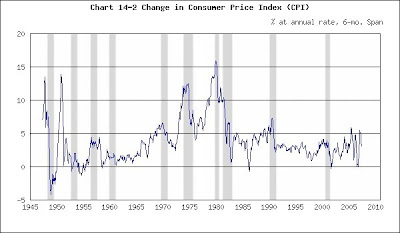
Recessions shaded
Yield on 10-year Treasury Bond
(Click on chart to enlarge)
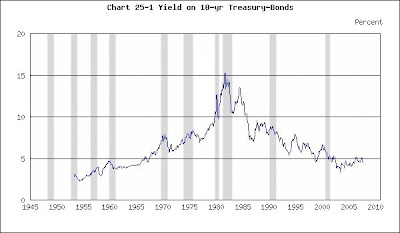
Recessions shaded
Consumer Confidence
(Click on chart to enlarge)

Recessions shaded
Housing Starts
(Click on chart to enlarge)
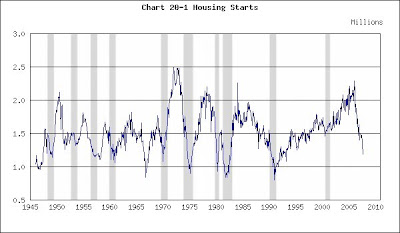
Recessions shaded
New-Vehicle Sales
(Click on chart to enlarge)

Recessions shaded
Now consider the dot.com bust. Inflation was a blip in the late 1990s and consumer confidence at record highs. Interest rates popped up slightly, but housing starts and auto sales remained strong. The consumer had nothing to do with that recession.
If you examine business investment spending, however, the locus of the 2001 recession comes immediately into focus. Investment in nondefense capital goods (equipment) and business inventories (stocks of goods awaiting sale) plunged. That was a classic business downturn.
New Orders for Nondefense Capital Goods
(Click on chart to enlarge)

Recessions shaded
Inventory Change
(Click on chart to enlarge)
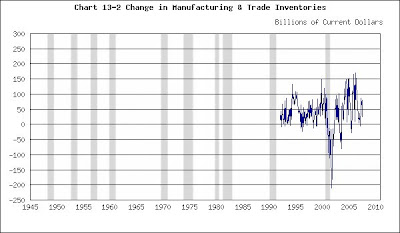
Recessions shaded
So where does that leave us? Let’s recapitulate. Inflation and interest rates are not on a runaway track, and consumer confidence has not (consequently) collapsed. It’s not obvious or inevitable that consumer spending must plunge. Meanwhile business capital expenditures and inventory accumulation remain strong. There’s no sign of slowdown there.
But take a look at the charts leading up to the 1990 recession. Inflation and interest rates were moderate and consumer confidence strong. Auto sales were robust, as were business capital expenditures. Yet falling building activity provided an omen of the slump to come. That sounds a lot like today’s story. Maybe today’s housing slump will also lead to recession.
Now keep the following in mind. The start of the First Persian Gulf War in 1990 had a severe impact on consumer confidence. Without the war there may not have been recession. So the 1990 recession may not be a good example because the war skewed everything.
Now you know why it’s more difficult to forecast the economy than it is to forecast the weather. The economic parameters change over time. The meteorological parameters do not.
Inflation is mild today, as it was in 1990. Does this protect the economy from recession? Will consumer confidence and spending remain high, confining the slump to residential construction? Will the economy soldier through because all problems are encapsulated in housing and there’ll be no metastasis to the rest of the economy? Will the economy’s vaunted flexibility tide us through again? The Fed seems to think so. Others (including this blogger) do not. It’s not easy to forecaste the economy.
(The charts are taken from http://www.beyourowneconomist.com. [Click on Seminars and then Charts.] Go there for additional charts on the economy and a list of economic indicators.)
This morning’s Wall Street Journal carried a gloomy lead article on the economic outlook: http://online.wsj.com/article/SB119602701188603294.html?mod=hps_us_whats_news. Three recent articles in The Economist : http://www.economist.com/world/na/displaystory.cfm?story_id=10134077
, The New York Times: http://www.businessweek.com/magazine/content/07_48/b4060001.htm
and Businessweek: http://www.nytimes.com/2007/11/25/weekinreview/25goodman.html?_r=1&oref=slogin also provided somber economic forecasts and warnings about consumer spending in particular. They made the case that this time it may indeed be different. Consumers will no longer have the easy access to credit that they had for the past 25 years. Less borrowing means less spending, and that’s bad for the economy. Meanwhile home prices are deflating while gasoline prices are inflating: Two more reasons to anticipate shrinking consumer demand and recession.
But these articles also point out that consumer spending has been counted out before, only to rise again and pull the economy along. The post-2001 expansion is the latest example. The Fed reflated consumer demand by depressing interest rates. Maybe the Fed will again reduce interest rates, and consumer demand and the economy will pop up once more.
Matter of fact, the Federal Reserve does not forecast recession. You can read the Fed’s entire report at: http://www.federalreserve.gov/monetarypolicy/files/fomcminutes20071031.pdf. Here’s a key quote:
“The projections … suggest that … in the near term, output will grow at a pace somewhat below its trend rate and the unemployment rate will edge higher, owing primarily to weakness in housing markets and to the tightening in the availability of credit resulting from recent strains in financial markets. Further ahead, output was projected to expand at a pace close to its long-run trend.”
That’s a forecast for mild slowdown, not recession.
So why is the turning point so hard to call? Why can’t economists agree on a forecast?
The answer is, “The absence of inflation.” If inflation was surging and consumer confidence slumping, then we could easily forecast recession. For instance, take a look at the direction of consumer prices and consumer confidence in the late 1970s. Prices were heading into the stratosphere, dragging interest rates with them. Consequently consumer confidence plunged into the basement and home construction and auto sales collapsed. That was a classic case of inflation-inspired recession.
Change in Consumer Prices (CPI)
(Click on chart to enlarge)

Recessions shaded
Yield on 10-year Treasury Bond
(Click on chart to enlarge)

Recessions shaded
Consumer Confidence
(Click on chart to enlarge)

Recessions shaded
Housing Starts
(Click on chart to enlarge)

Recessions shaded
New-Vehicle Sales
(Click on chart to enlarge)

Recessions shaded
Now consider the dot.com bust. Inflation was a blip in the late 1990s and consumer confidence at record highs. Interest rates popped up slightly, but housing starts and auto sales remained strong. The consumer had nothing to do with that recession.
If you examine business investment spending, however, the locus of the 2001 recession comes immediately into focus. Investment in nondefense capital goods (equipment) and business inventories (stocks of goods awaiting sale) plunged. That was a classic business downturn.
New Orders for Nondefense Capital Goods
(Click on chart to enlarge)

Recessions shaded
Inventory Change
(Click on chart to enlarge)

Recessions shaded
So where does that leave us? Let’s recapitulate. Inflation and interest rates are not on a runaway track, and consumer confidence has not (consequently) collapsed. It’s not obvious or inevitable that consumer spending must plunge. Meanwhile business capital expenditures and inventory accumulation remain strong. There’s no sign of slowdown there.
But take a look at the charts leading up to the 1990 recession. Inflation and interest rates were moderate and consumer confidence strong. Auto sales were robust, as were business capital expenditures. Yet falling building activity provided an omen of the slump to come. That sounds a lot like today’s story. Maybe today’s housing slump will also lead to recession.
Now keep the following in mind. The start of the First Persian Gulf War in 1990 had a severe impact on consumer confidence. Without the war there may not have been recession. So the 1990 recession may not be a good example because the war skewed everything.
Now you know why it’s more difficult to forecast the economy than it is to forecast the weather. The economic parameters change over time. The meteorological parameters do not.
Inflation is mild today, as it was in 1990. Does this protect the economy from recession? Will consumer confidence and spending remain high, confining the slump to residential construction? Will the economy soldier through because all problems are encapsulated in housing and there’ll be no metastasis to the rest of the economy? Will the economy’s vaunted flexibility tide us through again? The Fed seems to think so. Others (including this blogger) do not. It’s not easy to forecaste the economy.
(The charts are taken from http://www.beyourowneconomist.com. [Click on Seminars and then Charts.] Go there for additional charts on the economy and a list of economic indicators.)
Wednesday, November 21, 2007
Happy Thanksgiving!
The Lehmann Letter ©
The blogger will take a little break today prior to the holiday, and will return on Monday, November 26.
Have a great Thanksgiving!
The blogger will take a little break today prior to the holiday, and will return on Monday, November 26.
Have a great Thanksgiving!
Tuesday, November 20, 2007
Housing Starts Perk Up
The Lehmann Letter ©
This morning’s Census Bureau report (http://www.census.gov/const/newresconst.pdf) about housing start’s October improvement is good news. Starts had been 1.193 million in September and edged up to 1.229 million. That’s only a 3% gain, but does interrupt a downward slide. The following chart presents the trend.
Housing Starts
(Click on chart to enlarge)

Recessions shaded
Housing starts have fallen by about one million from their 2005 peak. Every slide of this magnitude since WWII has led to recession. The economy may dodge the bullet this time because there’s been no accompanying auto-sales slump. (The November 13 posting observed that housing and autos plunged together prior to earlier recessions.) It remains to be seen whether or not home-refinancing difficulties curtail auto sales.
The chart also makes clear that trends are interrupted by monthly wiggles in the data. We’ll see whether or not October’s rebound is a good omen or a false ray of hope.
But there’s a more-troubling fact behind the housing-starts number. The 1.229 million figure reported in the first paragraph includes apartment-house construction, and apartment construction has avoided the slump and even turned up lately. Single-family construction, on the other hand, fell from 954,000 in September to 884,000 in October. That’s a significant 7% decline. It shows that the fall in single-family activity (the eye of the storm) continues unabated.
The following charts present single-family activity and all confirm the trouble in that market.
Existing-Home Sales
(Click on chart to enlarge)

Recessions shaded
New-Home Sales
(Click on chart to enlarge)

Recessions shaded
Home sales are down and continue to fall. Why should builders start constructing new homes when there’s such difficulty moving the existing ones?
(The charts are copied from http://www.beyourowneconomist.com. [Click on Seminars and then Charts.] Go there for additional charts on the economy and a list of economic indicators.)
This morning’s Census Bureau report (http://www.census.gov/const/newresconst.pdf) about housing start’s October improvement is good news. Starts had been 1.193 million in September and edged up to 1.229 million. That’s only a 3% gain, but does interrupt a downward slide. The following chart presents the trend.
Housing Starts
(Click on chart to enlarge)

Recessions shaded
Housing starts have fallen by about one million from their 2005 peak. Every slide of this magnitude since WWII has led to recession. The economy may dodge the bullet this time because there’s been no accompanying auto-sales slump. (The November 13 posting observed that housing and autos plunged together prior to earlier recessions.) It remains to be seen whether or not home-refinancing difficulties curtail auto sales.
The chart also makes clear that trends are interrupted by monthly wiggles in the data. We’ll see whether or not October’s rebound is a good omen or a false ray of hope.
But there’s a more-troubling fact behind the housing-starts number. The 1.229 million figure reported in the first paragraph includes apartment-house construction, and apartment construction has avoided the slump and even turned up lately. Single-family construction, on the other hand, fell from 954,000 in September to 884,000 in October. That’s a significant 7% decline. It shows that the fall in single-family activity (the eye of the storm) continues unabated.
The following charts present single-family activity and all confirm the trouble in that market.
Existing-Home Sales
(Click on chart to enlarge)

Recessions shaded
New-Home Sales
(Click on chart to enlarge)

Recessions shaded
Home sales are down and continue to fall. Why should builders start constructing new homes when there’s such difficulty moving the existing ones?
(The charts are copied from http://www.beyourowneconomist.com. [Click on Seminars and then Charts.] Go there for additional charts on the economy and a list of economic indicators.)
Monday, November 19, 2007
Price Inflation, Asset Inflation & the Next Recession
The Lehmann Letter ©
Inflation provided the best indicator of imminent recession in the bad old days of the Old Economy (before the 1990s). Things “heated up” when booming demand boosted output so rapidly that capacity utilization rose above 85%. As productive facilities stretched to the maximum, turning out all the homes, autos (and everything else) they possibly could, productivity (efficiency) fell. Just as your gas mileage plummets and auto-operating costs rise when you press the accelerator to the floor, costs and prices (inflation) rose with a high-speed economy. Rising inflation depressed consumer sentiment and spending, while the Fed drove up interest rates to head off the excess demand that had started the binge. As consumer sentiment headed south and interest rates went north, consumer spending slumped and the economy lapsed into recession.
You can trace this sequence yourself in the charts below. Take a look at the late 1970s and late 1980s. As a robust economy drove up capacity utilization, productivity (efficiency) faltered, sending costs and inflation skyward and depressing consumer confidence. Interest rates rose, too, as the Fed tightened. Demand fell and recession followed.
Capacity Utilization
(Click on chart to enlarge)
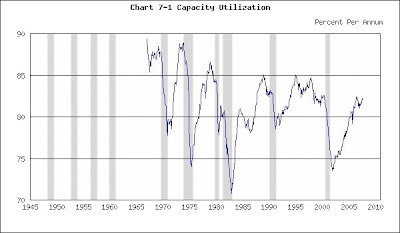
Inflation provided the best indicator of imminent recession in the bad old days of the Old Economy (before the 1990s). Things “heated up” when booming demand boosted output so rapidly that capacity utilization rose above 85%. As productive facilities stretched to the maximum, turning out all the homes, autos (and everything else) they possibly could, productivity (efficiency) fell. Just as your gas mileage plummets and auto-operating costs rise when you press the accelerator to the floor, costs and prices (inflation) rose with a high-speed economy. Rising inflation depressed consumer sentiment and spending, while the Fed drove up interest rates to head off the excess demand that had started the binge. As consumer sentiment headed south and interest rates went north, consumer spending slumped and the economy lapsed into recession.
You can trace this sequence yourself in the charts below. Take a look at the late 1970s and late 1980s. As a robust economy drove up capacity utilization, productivity (efficiency) faltered, sending costs and inflation skyward and depressing consumer confidence. Interest rates rose, too, as the Fed tightened. Demand fell and recession followed.
Capacity Utilization
(Click on chart to enlarge)

Recessions shaded
Consumer Prices
(Click on chart to enlarge)
Consumer Prices
(Click on chart to enlarge)
Recessions shaded
Consumer Confidence
(Click on chart to enlarge)
Consumer Confidence
(Click on chart to enlarge)
Recessions shaded
When the New Economy advocates of the 1990s promised, “This time it’s different. There won’t be a recession,” the dot.com bust proved them wrong. The New Economy did not abolish recession, but the Old Economy rules did fall by the wayside. In the late 1990s consumer confidence climbed to a record high in a climate of moderate capacity utilization and inflation. How had the economy achieved boom without inflation?
Because “this time is different” occurred in a way that few anticipated. This time inflationary pressures channeled into assets (such as the stock market) that are not included in the Consumer Price Index (CPI), instead of channeling into goods and services (such as building materials) that are included in the CPI. The New Economy had added so much hi-tech productive capacity that output surged with less effort than in the past. In addition more demand went overseas into low-cost imports. Consequently inflation and interest rates didn’t escalate and consumer confidence didn’t droop. At the same time, investors diverted their growing incomes into the stock market. When recession struck, it did so for non- traditional reasons: A profit-margin squeeze generated by rising wages (rather than a demand contraction) depressed business confidence and investment.
The Fed employed low interest rates to resuscitate the economy after the 2001 recession. Once again, ample productive capacity restrained capacity utilization and inflation, enabling consumers to channel their rising real incomes into home purchases (which are not in the CPI). That instigated another boom and the real-estate bubble. If recession hits, it won’t be because consumer sentiment faltered due to rising prices and the Fed’s restrictive policies. Recession will occur because another asset bubble deflated, reminiscent of the dot.com bust that came on the heels of the dot.com boom.
When the New Economy advocates of the 1990s promised, “This time it’s different. There won’t be a recession,” the dot.com bust proved them wrong. The New Economy did not abolish recession, but the Old Economy rules did fall by the wayside. In the late 1990s consumer confidence climbed to a record high in a climate of moderate capacity utilization and inflation. How had the economy achieved boom without inflation?
Because “this time is different” occurred in a way that few anticipated. This time inflationary pressures channeled into assets (such as the stock market) that are not included in the Consumer Price Index (CPI), instead of channeling into goods and services (such as building materials) that are included in the CPI. The New Economy had added so much hi-tech productive capacity that output surged with less effort than in the past. In addition more demand went overseas into low-cost imports. Consequently inflation and interest rates didn’t escalate and consumer confidence didn’t droop. At the same time, investors diverted their growing incomes into the stock market. When recession struck, it did so for non- traditional reasons: A profit-margin squeeze generated by rising wages (rather than a demand contraction) depressed business confidence and investment.
The Fed employed low interest rates to resuscitate the economy after the 2001 recession. Once again, ample productive capacity restrained capacity utilization and inflation, enabling consumers to channel their rising real incomes into home purchases (which are not in the CPI). That instigated another boom and the real-estate bubble. If recession hits, it won’t be because consumer sentiment faltered due to rising prices and the Fed’s restrictive policies. Recession will occur because another asset bubble deflated, reminiscent of the dot.com bust that came on the heels of the dot.com boom.
Friday, November 16, 2007
Industrial Production & Capacity Utilization
Be Your Own Economist ®
The Lehmann Letter ©
Friday
November 16, 2007
Industrial Production & Capacity Utilization
This morning the Federal Reserve (the Fed) reported that October industrial production had fallen half a percent from September to 114.6 (2002 = 100). It’s been flat all summer and into the fall.
Industrial production measures the output of the mining, manufacturing and public utilities industries. It’s recorded as an index, with 2002 set at 100, so that a single figure can represent the activity of a variety of industries that measure their results in tons, yards, kilowatts and so on. That way, one number can represent all.
This release will help you understand why economic forecasting is not easy. There will be two reactions to it. The first will say, ”Bad news. This confirms that the economy is faltering. It’s down hill from here.” The second will say, “Good news. This confirms that the economy is not over heating. The Fed won’t have to raise interest rates.”
The chart below presents industrial production’s record: Mostly up, except for recessions. That makes it difficult to grasp the polar extremes of the last paragraph. To appreciate those extremes, look at the next chart that portrays capacity utilization. It illustrates matters quite well.
Industrial Production (Recessions shaded)
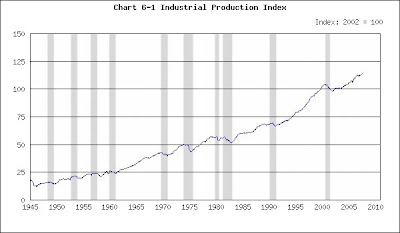
Capacity Utilization (Recessions shaded)

Capacity utilization asks and answers the following question, “What is the current level of industrial output expressed as a percentage of the maximum?” Thus, if a factory can produce 100 tons of stuff per day and is currently generating 90, it is operating at 90% of capacity.
The Fed reported October’s figure at 81.7%. The record shows capacity utilization as flat all summer and into the fall. Once again, some will say “bad news” and others will say “good news.”
Fortunately the capacity-utilization chart is easier to interpret than the industrial-production chart. Because capacity utilization presents a ratio between two numbers – what we can produce and what we are producing – you can intuitively understand that a very high figure indicates we are straining productive facilities while a low number indicates slack in the economy. Anything above 85% means we’re pushing too hard, leading to inefficiency and rising cost and prices. Between 80% and 85% is ideal. Under 80% runs the risk of slump.
Think of your car’s engine as an analogy. If you push the accelerator to the floor and drive too fast, you strain the engine and fuel efficiency – measured in miles per gallon – falls. It’s an expensive ride. But a relaxed, even speed, say 50 miles per hour, will maximize fuel efficiency and reduce driving costs. The economy is like an engine. A leisurely pace is most efficient.
Right now, at 81.7% of capacity, the economy is operating at its sweet spot. There’s no need for the Fed to speed it up or slow it down. Keep track of this number in coming months to see whether it rises or falls. Here’s how:
Industrial Production & Capacity Utilization
http://www.federalreserve.gov/
Step 1: Click on "All Statistical Releases" under "Recent Statistical Releases" and then click on "Industrial Production and Capacity Utilization" under "Principal Economic Indicators" in the upper left
Step 2: Click on "Current Monthly Release"
Step 3: Find the latest monthly data in the table next to "Total index" and "Total industry"
The Lehmann Letter ©
Friday
November 16, 2007
Industrial Production & Capacity Utilization
This morning the Federal Reserve (the Fed) reported that October industrial production had fallen half a percent from September to 114.6 (2002 = 100). It’s been flat all summer and into the fall.
Industrial production measures the output of the mining, manufacturing and public utilities industries. It’s recorded as an index, with 2002 set at 100, so that a single figure can represent the activity of a variety of industries that measure their results in tons, yards, kilowatts and so on. That way, one number can represent all.
This release will help you understand why economic forecasting is not easy. There will be two reactions to it. The first will say, ”Bad news. This confirms that the economy is faltering. It’s down hill from here.” The second will say, “Good news. This confirms that the economy is not over heating. The Fed won’t have to raise interest rates.”
The chart below presents industrial production’s record: Mostly up, except for recessions. That makes it difficult to grasp the polar extremes of the last paragraph. To appreciate those extremes, look at the next chart that portrays capacity utilization. It illustrates matters quite well.
Industrial Production (Recessions shaded)

Capacity Utilization (Recessions shaded)

Capacity utilization asks and answers the following question, “What is the current level of industrial output expressed as a percentage of the maximum?” Thus, if a factory can produce 100 tons of stuff per day and is currently generating 90, it is operating at 90% of capacity.
The Fed reported October’s figure at 81.7%. The record shows capacity utilization as flat all summer and into the fall. Once again, some will say “bad news” and others will say “good news.”
Fortunately the capacity-utilization chart is easier to interpret than the industrial-production chart. Because capacity utilization presents a ratio between two numbers – what we can produce and what we are producing – you can intuitively understand that a very high figure indicates we are straining productive facilities while a low number indicates slack in the economy. Anything above 85% means we’re pushing too hard, leading to inefficiency and rising cost and prices. Between 80% and 85% is ideal. Under 80% runs the risk of slump.
Think of your car’s engine as an analogy. If you push the accelerator to the floor and drive too fast, you strain the engine and fuel efficiency – measured in miles per gallon – falls. It’s an expensive ride. But a relaxed, even speed, say 50 miles per hour, will maximize fuel efficiency and reduce driving costs. The economy is like an engine. A leisurely pace is most efficient.
Right now, at 81.7% of capacity, the economy is operating at its sweet spot. There’s no need for the Fed to speed it up or slow it down. Keep track of this number in coming months to see whether it rises or falls. Here’s how:
Industrial Production & Capacity Utilization
http://www.federalreserve.gov/
Step 1: Click on "All Statistical Releases" under "Recent Statistical Releases" and then click on "Industrial Production and Capacity Utilization" under "Principal Economic Indicators" in the upper left
Step 2: Click on "Current Monthly Release"
Step 3: Find the latest monthly data in the table next to "Total index" and "Total industry"
Publication Schedule & Web Sources
Be Your Own Economist ®
The Lehmann Letter ©
Friday
November 16, 2007
Publication Schedule & Web Sources
Here is a publication schedule of important economic indicators for the remainder of November, followed by a list of web sources for those data. Future postings will discuss the indicators as they appear, starting with today’s release of figures for industrial production and capacity utilization.
You can use the WEB SOURCES listing to find the data on your own and read the press release that often accompanies the data. The addresses take you to the source’s home page and the steps tell you how to find the data once you are there. That way (rather than provide a direct link to the data) you can become familiar with these official sites and find additional information on your own.
Use this blog’s analysis and charts, together with the information you gather from the official sites, to become your own economist.
PUBLICATION SCHEDULE
Remainder of November 2007
Source (* below).............Series Description..................Day & Date
Monthly Data
Fed..................................Capacity utilization..................Fri, 16th
Fed..................................Industrial production.............. Fri, 16th
Census.............................Housing starts..........................Tue, 20th
Census.............................Capital goods............................Wed, 28th
NAR................................Existing-home sales.................Wed, 28th
Census.............................New-home sales......................Thu, 29th
BEA..................................Personal income......................Fri, 30th
Quarterly Data
BEA.................................GDP..........................................Thu, 29th
BEA.................................Profits.......................................Thu, 29th
* BEA = Bureau of Economic Analysis of the U.S. Department of Commerce
* Census = U.S. Bureau of the Census
* Fed = Federal Reserve System
* NAR = National Association of Realtors
WEB SOURCES
After-tax Corporate Profits
http://www.bea.gov/
Step 1: Click on "Gross Domestic Product" under "National"
Step 2: Click on "National Income and Product Accounts Tables" under "Gross Domestic Product (GDP)"
Step 3: Click on "list of all NIPA Tables"
Step 4: Click on "Table 1.12. National Income by Type of Income (A) (Q)"
Step 5: Scroll down to line 46 and go to the last column on the right
Gross Domestic Product
http://www.bea.gov/
Step 1: Click on "Gross Domestic Product" under "National"
Step 2: Click on "National Income and Product Accounts Tables" under "Gross Domestic Product (GDP)"
Step 3: Click on "list of all NIPA Tables"
Step 4: Click on "Table 1.1.6. Real Gross Domestic Product..." and "Table 1.1.1. Percent Change..."
Step 5: Scroll down to line 1 in both tables and go to the last column on the right
Industrial Production & Capacity Utilization
http://www.federalreserve.gov/
Step 1: Click on "All Statistical Releases" under "Recent Statistical Releases" and then click on "Industrial Production and Capacity Utilization" under "Principal Economic Indicators" in the upper left
Step 2: Click on "Current Monthly Release"
Step 3: Find the latest monthly data in the table next to "Total index" and "Total industry"
Housing Starts
http://www.census.gov/
Step 1: Click on "Economic Indicators" in the lower right
Step 2: Click on "PDF" on the left under "Current Press Release" under "Housing Starts/Building Permits"
Step 3: Scroll down to "Housing Starts"
Business Capital Expenditures (Nondefense Capital Goods)
http://www.census.gov/
Step 1: Click on "Economic Indicators" in the lower right
Step 2: Click on "PDF" on the left under "Advance Report on Durable Goods Manufacturers' Shipments and Orders"
Step 3: Scroll down to Table 1 and find new orders for nondefense capital goods near the bottom
Home Sales (Existing-Home Sales)
http://www.realtor.org/
Step 1: Click on "Research" in the left-hand menu bar
Step 2: Find "Existing-Home Sales" under "Housing Indicators"
Home Sales (New-Home Sales)
http://www.census.gov/
Step 1: Click on "Economic Indicators" in the lower right
Step 2: Click on "PDF" on the left under "Current Press Release" under "New Home Sales"
Personal Income
http://www.bea.gov/
Step 1: Click on "Gross Domestic Product" under "National"
Step 2: Click on "National Income and Product Accounts Tables" under "Gross Domestic Product (GDP)"
Step 3: Click on "list of all NIPA Tables"
Step 4: Click on "Table 2.6 Personal Income..."
Step 5: Scroll down to line 1
The Lehmann Letter ©
Friday
November 16, 2007
Publication Schedule & Web Sources
Here is a publication schedule of important economic indicators for the remainder of November, followed by a list of web sources for those data. Future postings will discuss the indicators as they appear, starting with today’s release of figures for industrial production and capacity utilization.
You can use the WEB SOURCES listing to find the data on your own and read the press release that often accompanies the data. The addresses take you to the source’s home page and the steps tell you how to find the data once you are there. That way (rather than provide a direct link to the data) you can become familiar with these official sites and find additional information on your own.
Use this blog’s analysis and charts, together with the information you gather from the official sites, to become your own economist.
PUBLICATION SCHEDULE
Remainder of November 2007
Source (* below).............Series Description..................Day & Date
Monthly Data
Fed..................................Capacity utilization..................Fri, 16th
Fed..................................Industrial production.............. Fri, 16th
Census.............................Housing starts..........................Tue, 20th
Census.............................Capital goods............................Wed, 28th
NAR................................Existing-home sales.................Wed, 28th
Census.............................New-home sales......................Thu, 29th
BEA..................................Personal income......................Fri, 30th
Quarterly Data
BEA.................................GDP..........................................Thu, 29th
BEA.................................Profits.......................................Thu, 29th
* BEA = Bureau of Economic Analysis of the U.S. Department of Commerce
* Census = U.S. Bureau of the Census
* Fed = Federal Reserve System
* NAR = National Association of Realtors
WEB SOURCES
After-tax Corporate Profits
http://www.bea.gov/
Step 1: Click on "Gross Domestic Product" under "National"
Step 2: Click on "National Income and Product Accounts Tables" under "Gross Domestic Product (GDP)"
Step 3: Click on "list of all NIPA Tables"
Step 4: Click on "Table 1.12. National Income by Type of Income (A) (Q)"
Step 5: Scroll down to line 46 and go to the last column on the right
Gross Domestic Product
http://www.bea.gov/
Step 1: Click on "Gross Domestic Product" under "National"
Step 2: Click on "National Income and Product Accounts Tables" under "Gross Domestic Product (GDP)"
Step 3: Click on "list of all NIPA Tables"
Step 4: Click on "Table 1.1.6. Real Gross Domestic Product..." and "Table 1.1.1. Percent Change..."
Step 5: Scroll down to line 1 in both tables and go to the last column on the right
Industrial Production & Capacity Utilization
http://www.federalreserve.gov/
Step 1: Click on "All Statistical Releases" under "Recent Statistical Releases" and then click on "Industrial Production and Capacity Utilization" under "Principal Economic Indicators" in the upper left
Step 2: Click on "Current Monthly Release"
Step 3: Find the latest monthly data in the table next to "Total index" and "Total industry"
Housing Starts
http://www.census.gov/
Step 1: Click on "Economic Indicators" in the lower right
Step 2: Click on "PDF" on the left under "Current Press Release" under "Housing Starts/Building Permits"
Step 3: Scroll down to "Housing Starts"
Business Capital Expenditures (Nondefense Capital Goods)
http://www.census.gov/
Step 1: Click on "Economic Indicators" in the lower right
Step 2: Click on "PDF" on the left under "Advance Report on Durable Goods Manufacturers' Shipments and Orders"
Step 3: Scroll down to Table 1 and find new orders for nondefense capital goods near the bottom
Home Sales (Existing-Home Sales)
http://www.realtor.org/
Step 1: Click on "Research" in the left-hand menu bar
Step 2: Find "Existing-Home Sales" under "Housing Indicators"
Home Sales (New-Home Sales)
http://www.census.gov/
Step 1: Click on "Economic Indicators" in the lower right
Step 2: Click on "PDF" on the left under "Current Press Release" under "New Home Sales"
Personal Income
http://www.bea.gov/
Step 1: Click on "Gross Domestic Product" under "National"
Step 2: Click on "National Income and Product Accounts Tables" under "Gross Domestic Product (GDP)"
Step 3: Click on "list of all NIPA Tables"
Step 4: Click on "Table 2.6 Personal Income..."
Step 5: Scroll down to line 1
Subscribe to:
Posts (Atom)


